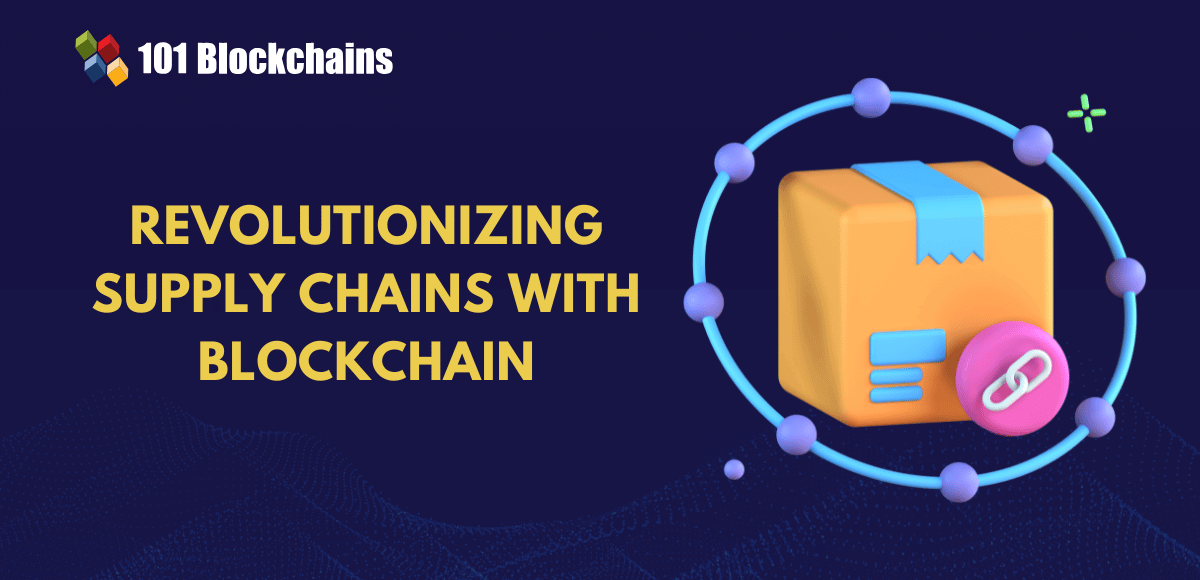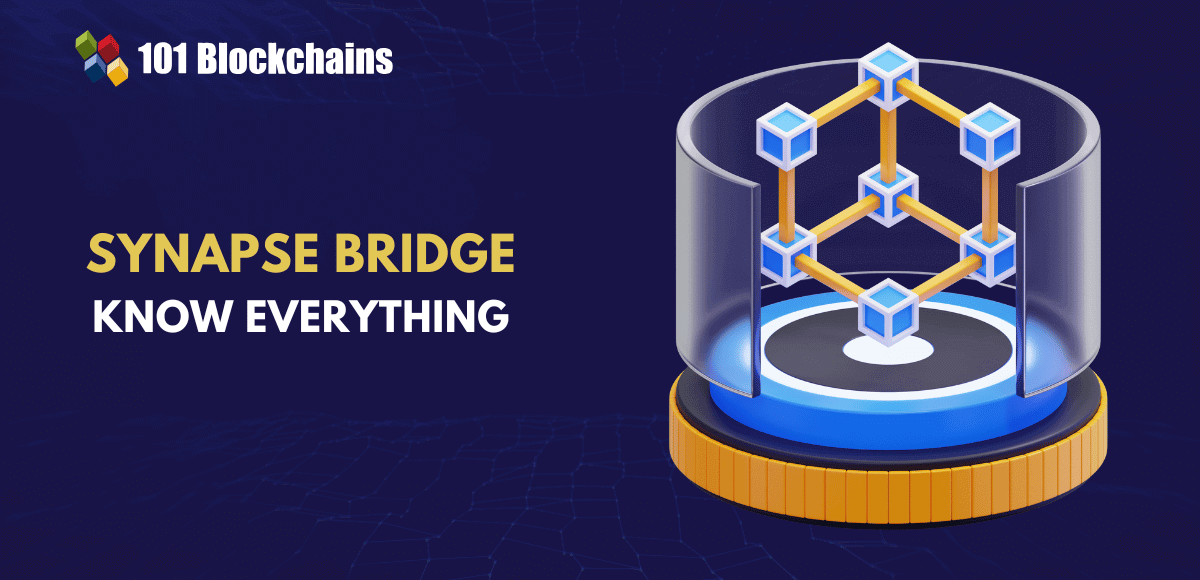Learn how blockchain truly works, master key definitions, and uncover what makes smart contracts so "smart." Dive into the fundamentals, gain valuable insights, and start your blockchain journey today!

- Blockchain
Hasib Anwar
- on March 24, 2019
Blockchain For Enterprise: Free Training Guide
Blockchain for enterprise is on its way to pave the way for the future. Many organizations now are trying to invest in enterprise blockchain platform and enhance their business model for good. Enterprise blockchains focus mainly on the features of enterprise-grade companies and how it can solve the issues this industry faces.
Given the enormous value blockchain for enterprise networks bring us, you need to find some time to invest in enterprise blockchain training. To make sure you know what you are dealing with, we will be covering every aspect of blockchain for enterprise to enlighten you on the topic.
So, let’s get started!
Want to become a valuable blockchain expert? Enroll in Certified Enterprise Blockchain Professional (CEBP) course now and learn blockchain in detail!
Table of Contents
Chapter-1: Fundamentals of Blockchain Technology
Chapter-2: Can Use Cases Overpower The Implementation Challenges?
Chapter-3: Enterprise Projects in Non-financial and Federated Networks
Chapter-4: Enterprise Blockchains: BAAS Vendors and Popular Platforms
Chapter-5: Hyperledger Ecosystem
Chapter-6: Blockchain in Healthcare and Government
Chapter-7: Decentralized Internet and Web 3.0
Chapter-8: Top Blockchain Adoption Challenges
Chapter-9: The Transformation Playbook
Chapter-1: Fundamentals of Blockchain Technology
Public vs. Private: The Battle of Two Popular Blockchain Technology
Let’s go back right from the start. Blockchain technology became first recognized when Satoshi Nakamoto introduced Bitcoin that runs on this new decentralized technology. We think you already know by now that Bitcoin a public blockchain. Anyone can join the network and can use it freely without any restrictions.
Soon after public blockchain became popular new public blockchain such as Ethereum started to thrive the market, and the popularity is still growing. But now the scene is changing drastically. Enterprises or big companies are more eager to work with private enterprise blockchain technology rather than public blockchain.
But why?
Public VS Private Blockchain Network Infographic
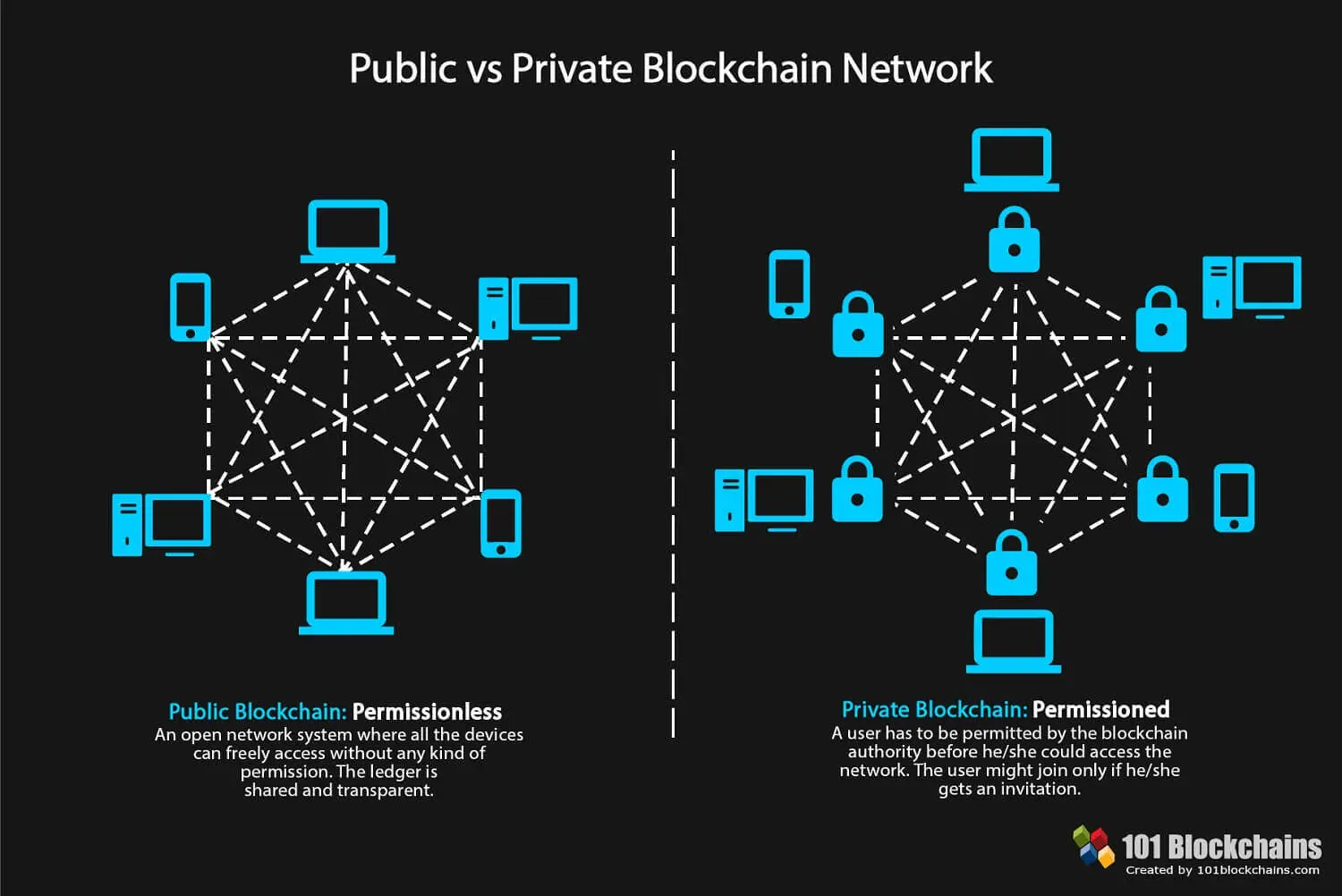
Please include attribution to 101blockchains.com with this graphic. <a href='https://101blockchains.com/blockchain-infographics/'> <img src='https://101blockchains.com/wp-content/uploads/2018/07/Public_vs_Private_Blockchain.jpg' alt='Public vs Private Blockchain='0' /> </a>
Transitioning to Private Enterprise Blockchain Technology
Public blockchains have a lot of features, but the open environment isn’t suited for every kind of company. Many companies have to deal with sensitive information, and they need a secure channel where they can store or deal with the documentation.
In this regard, Private enterprise blockchain solution came into play. These private enterprise blockchain solution could give them the privacy they need along with features they can use. However, this type of blockchain solution is mostly suited for banks or financial institutions. But now many enterprises are more than eager to work with both kinds of blockchain.
So, the ecosystem of the enterprise blockchain solution is changing and will keep changing drastically in the coming days. But what are the common features of blockchain technology that is making every industry to implement it? Let’s check it out now!
Basic Features of Blockchain Technology
So, we already talked a bit about enterprise blockchain. But if you aren’t familiar with this new kind of network system then lets us clear up the concept before we jump into the key features of blockchain technology.
So, What is Enterprise Blockchain?
All the enterprise blockchain on the market is specially equipped to meet with all organizational demands. In simple terms, these networks are made for enterprise blockchain solutions. So, if an enterprise wants to integrate a blockchain technology that can offer special features only for them, then those networks are called enterprise blockchain.
For more information try out our blockchain for enterprise pdf and enterprise blockchains ppt.
Now that you know what enterprise blockchain is, it’s time for us to see what features make blockchain so perfect for enterprises. Let’s start!
Not sure how to build your career in enterprise blockchains? Enroll Now – How to Build Your Career in Enterprise Blockchains
Fundamentals of Enterprise Blockchain Infographic
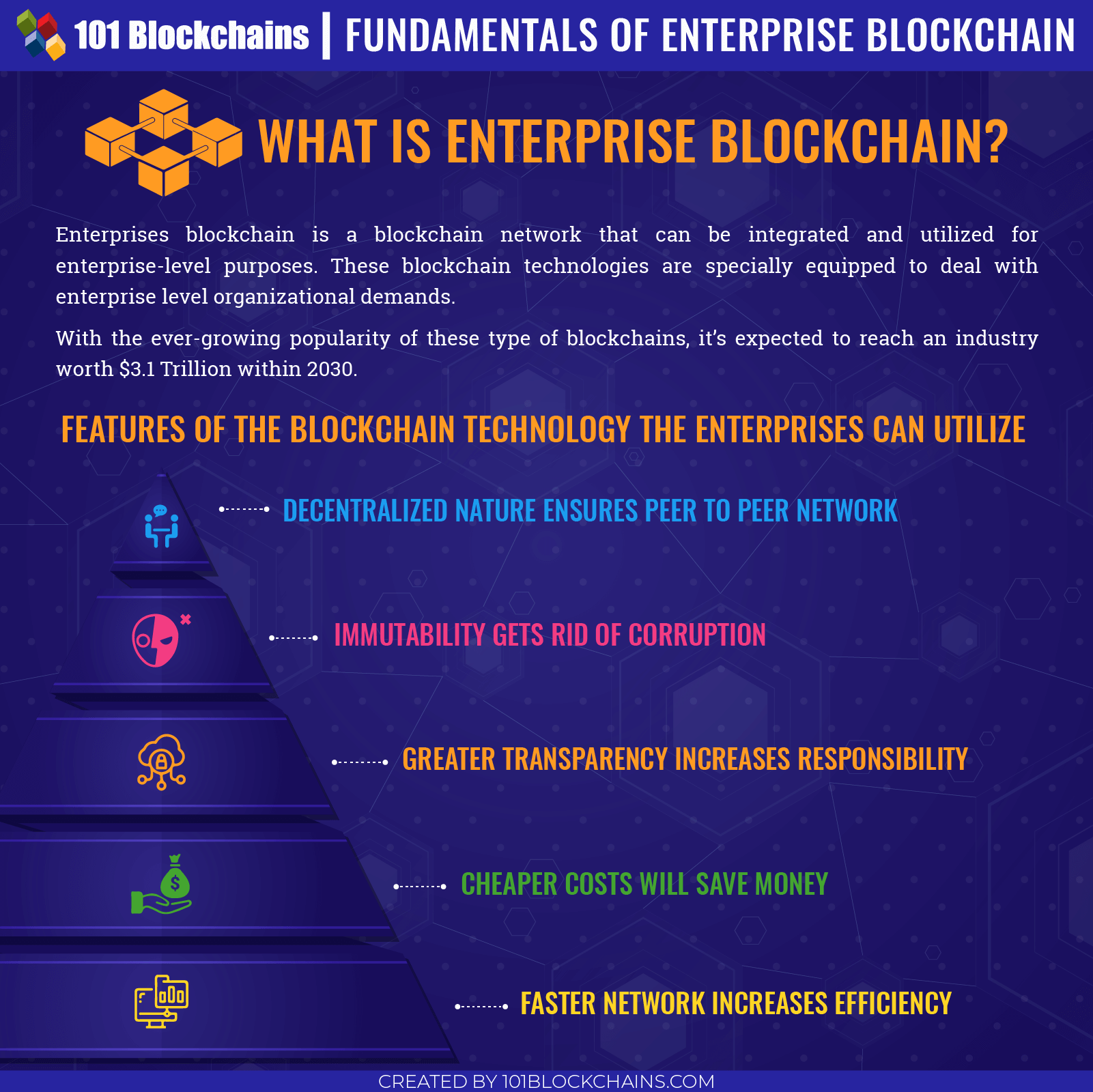
Please include attribution to 101blockchains.com with this graphic. <a href='https://101blockchains.com/blockchain-infographics/'> <img src='https://101blockchains.com/wp-content/uploads/2019/03/Fundamentals-of-Enterprise-Blockchain.png' alt='Fundamentals of Enterprise Blockchain='0' /> </a>
Key Features of Blockchain for Enterprises
-
Decentralized Nature
The typical client-server comes with some major issues. Often the server is vulnerable, and firewall services aren’t strong enough to hold off hackers. This is the usual network structure of many enterprises and even spending money on security protocols; they aren’t able to stop these bad players.
This is where the decentralization nature of the blockchain comes into play. Blockchain for enterprise offers a peer-to-peer network system, so there isn’t any central authority to sabotage the ledger system. Moreover, the control will be on the user’s hands now!
-
Immutable Structure
It’s another great feature that the blockchain for enterprise projects are a fan of. Immutability makes the ledger system into a firewall. In this case, if a block gets added to the ledger once, no one will be able ever to change or alter it. However, in some cases, enterprises may have other requirements.
But in most cases, no corrupt person can change the ledger and get more privilege.
-
Greater Transparency
Blockchain offers a greater level of transparency. It means that all the information on the ledger system is out in the open for the users on the network to see. But blockchain can also offer authentication process and level access to protect certain sensitive information for enterprises too.
Even so, the level of transparency is huge, so users can see what other users are doing, although their identity might remain hidden. So, you’ll only be able to see the public address of a person.
-
Cheaper Costs
It might seem a bit costly to develop your very own blockchain, but we have a solution for that. Many BAAS providers offer these solutions at a much cheaper rate then you would have needed to develop.
So, you can cut the cost of developers or even network managers, and enterprise blockchain solution comes with manage networks too. This is a feature that many enterprises can use to upgrade their internal network.
-
Fast Output
Every enterprise needs a fast output, don’t they? Many enterprises deal with loads of payments every day, to streamline these they can leverage blockchain technology’s fast output feature. This feature enables the creation of blockchain for enterprise projects.
Many platforms are capable of competing for a transaction within 20 seconds or even less! This is an insanely fast output compared to banks taking three or even six days!
Here’s another great infographic for your guys to figure out the core blockchain features –
Key Features of Blockchain Technology Infographic

Please include attribution to 101blockchains.com with this graphic. <a href='https://101blockchains.com/blockchain-infographics/'> <img src='https://101blockchains.com/wp-content/uploads/2018/05/Key-Blockchain-Features.png' alt='Key Blockchain Features='0' /> </a>
History of Blockchain Technology: How Much The Blockchain Evolved?
Many of you might think that people are overhyping blockchain technology. In some cases that may be true. But that being said, if we look at the history of the blockchain technology we would know how much the technology evolved. So, let’s take a look!
The History of Blockchain Technology Infographic
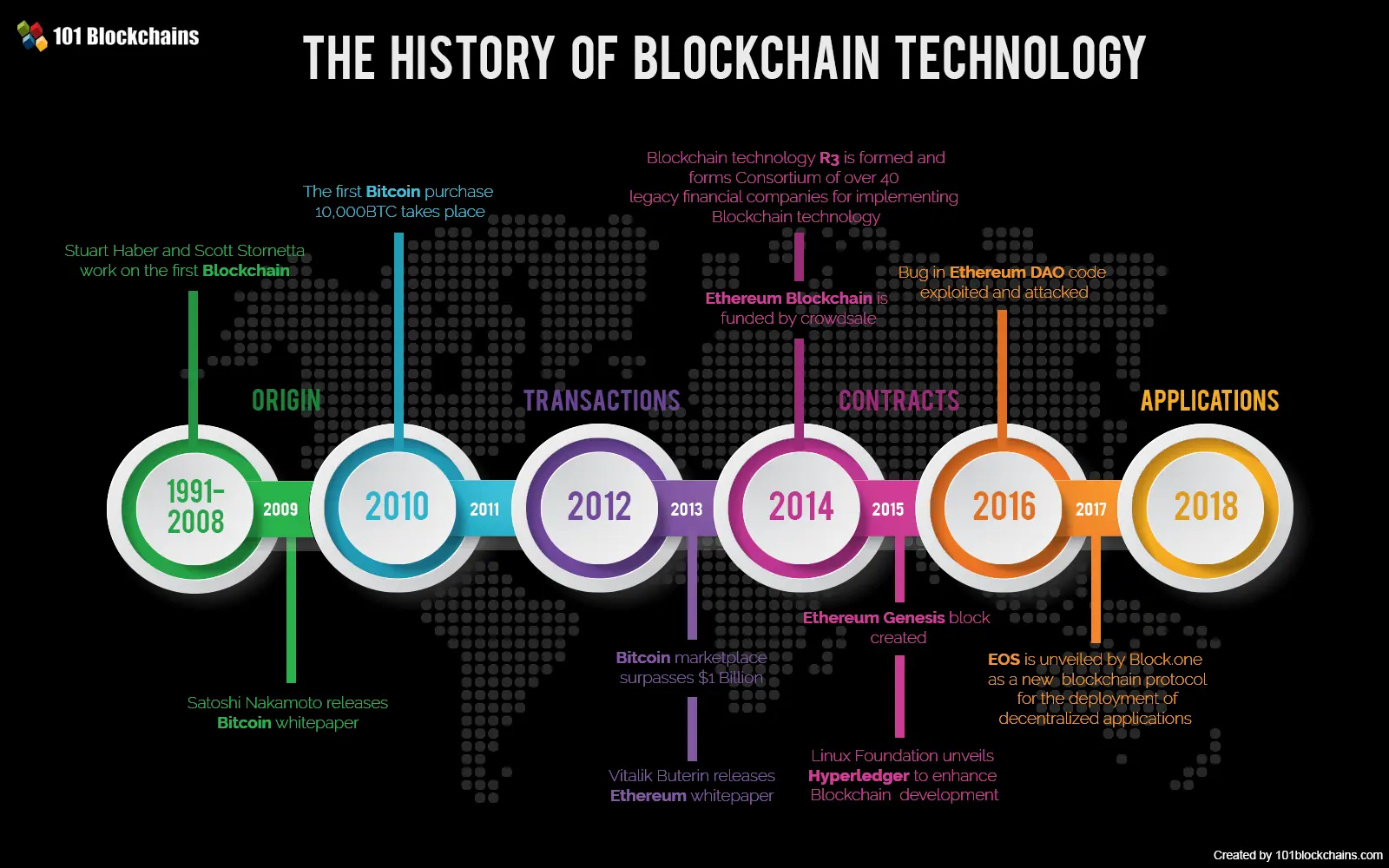
Please include attribution to 101blockchains.com with this graphic. <a href='https://101blockchains.com/blockchain-infographics/'> <img src='https://101blockchains.com/wp-content/uploads/2018/10/History_of_Blockchain_Technology.png' alt='History of Blockchain Technology='0' /> </a>
1991-2008: When Blockchain Was Still a Sprout
You must be wondering why the year 1991? Well, not many of us know it, but blockchain technology came to be from 1991. W. Scott Stornetta and Stuart Haber first envisioned the concept of the blockchain. So, they worked on a cryptographic system where there would be a chain of blocks that no one can tamper with. In 1992, they upgraded the system to make it more efficient.
But the tech gained more limelight in 2008 when Satoshi Nakamoto released a working blockchain technology platform for anyone to use. After a year, the whitepaper of bitcoin was released.
2008-2013: Blockchain 1.0 – Where Bitcoin Starts to Bloom
Don’t confuse with Bitcoin and Blockchain; they aren’t the same thing. Bitcoin is a cryptocurrency where Blockchain is the technology of the platform is uses.
After that bitcoin started to gain popularity and the capabilities of this platform increased. Many started to leverage the core concept and develop newer applications.
2013-2015: Blockchain 2.0 – Ethereum Platform Was Alive
Bitcoins blockchain platform was great, but it was limited in a way. So, developers started to find ways to harness the potential of this enterprise blockchain platform. At last in 2013, Ethereum platform came to be, and the functionally shifted to a new edge.
The new features didn’t limit the platform just to be used for a cryptocurrency, but it also helped other developers to build an application on it.
But it officially released in 2015, and it became one of the biggest leading industry till now.
Another thing happened within this time frame that gave us a new perspective of enterprise blockchain technology. R3 came to be from 2014 where they formed a consortium of 40 organizations. After that, the technology of R3 Corda started to have a strong presence in most financial sectors.
In the final year of this timeline, The Linux foundation started to gain interest in the technology and wanted to offer enterprise blockchain solutions for companies. So, they formed an open source blockchain umbrella project Hyperledger.
Hyperledger now has a lot of projects under its wings. Moreover, with Hyperledger the blockchain for enterprise finally started to get the hype they needed. Hyperledger induced a new structure of blockchain, and they are still introducing many solutions for cross-industry environments.
2017: EOS.IO
In 2017, a new kind of technology EOS came to be. The company block. one published their whitepaper on this enterprise blockchain platform that emulates the real computers including GPU and CPU.
For this, EOS can offer double the speed of smart contract processing in any decentralized environment.
2018 – Present Day: Blockchain 3.0 – A New Innovation Awaits
As you can see blockchain did evolve over the years and it’s still growing. With the introduction of Corda and Hyperledger now blockchain for business can focus on permissioned type blockchains. We still don’t know how things will turn out, but we can say for sure this isn’t the end of blockchain for enterprise but only the beginning.
It’s time for us to dive deeper into the roots of different kinds of blockchains networks. With evolution, blockchain is no longer only private or public but much more breached out. So, let’s see what they are in our next sections. Also, check out our blockchain for enterprise pdf and enterprise blockchains ppt for more info.
Different Types of Blockchain for Enterprise
With the evolution of blockchain now we see more than two kinds of blockchain for enterprise projects. All these new enterprise blockchain technologies are now creating more enterprise blockchain solutions for the customers.
Check these out these types of blockchain get a clear idea about them.
Different Types of Blockchain Technology For Enterprises Infographic
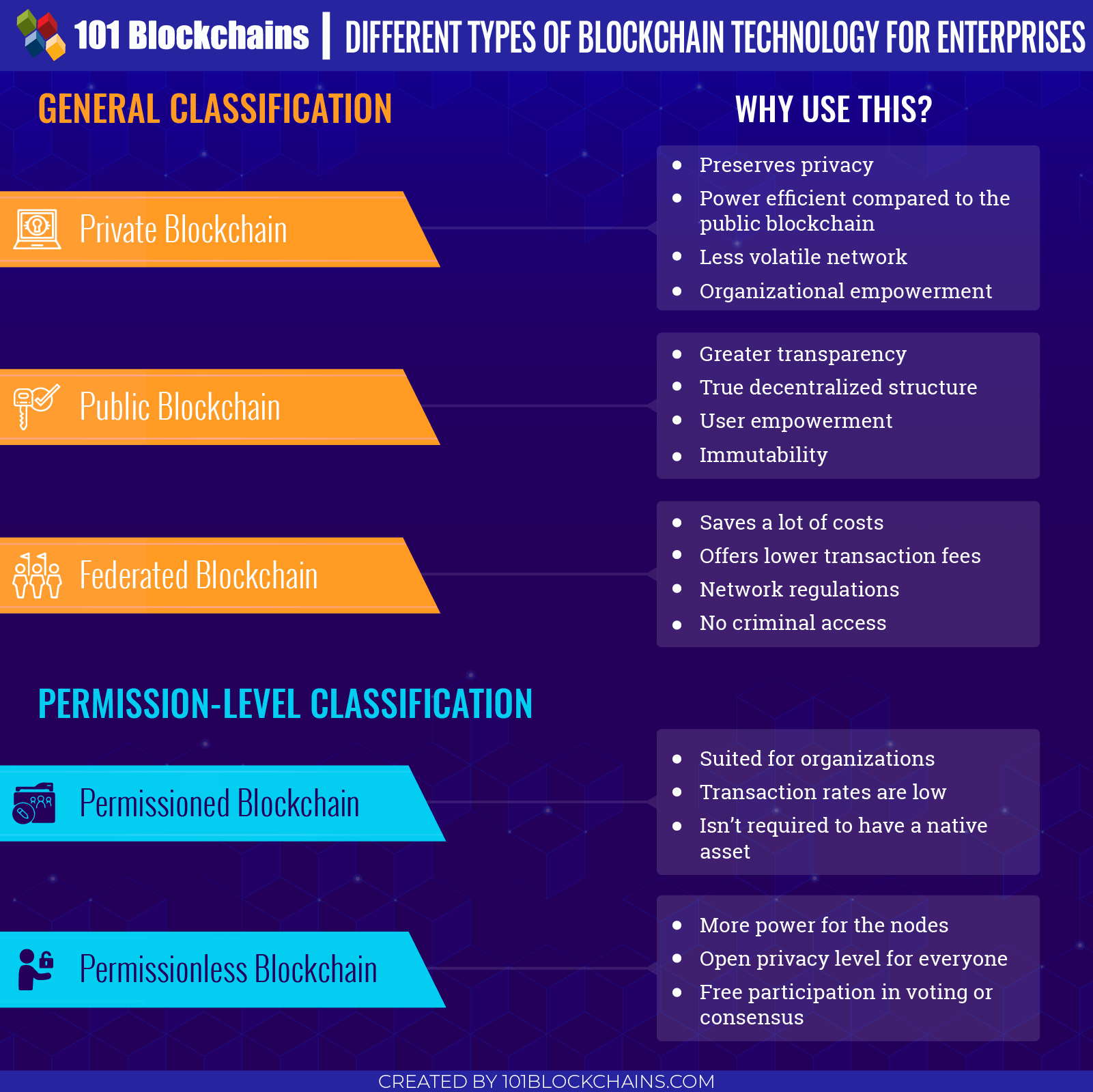
Please include attribution to 101blockchains.com with this graphic. <a href='https://101blockchains.com/blockchain-infographics/'> <img src='https://101blockchains.com/wp-content/uploads/2019/03/Different_Types_of_blockchain_technology_for_Enterprises.png' alt='Different Types of blockchain technology for Enterprises='0' /> </a>
General Classification –
1. Private
In private blockchains, you will see a single organization to authorize access over who can join the network. It’s more of like a centralized-decentralized blockchain for enterprises.
It might not seem like a proper decentralized network, but the core values are still there. If you have proper authorization, you can access these networks. But there will be a governing authority to look after the enterprise blockchain technology.
Special Characteristics
- Read or Write access varies from node to node
- Faster output
- Can use any type of asset on the network
- Does not offer anonymity
- Cheaper compared to the public blockchain
Why Use This?
- Preserves privacy
- Power efficient compared to the public blockchain
- Less volatile network
- Organizational empowerment
2. Public
In a public blockchain, any user will be able to join the network and participate in consensus. Moreover, all the users can see the ledger so that you will get full transparency.
So, this kind of blockchain for enterprise networks are more decentralized, as you literally have no central author watching over you.
Special Characteristics
- Everyone has access to the network
- Can download and add nodes
- Fully decentralized in nature
- Slower output
- Offers anonymity
Why Use This?
- Greater transparency
- True decentralized structure
- User empowerment
- Immutability
3. Federated
In federated blockchain, multiple organizations influence the blockchain network. It’s similar to a hub for a vast number of organizations to share and work concurrently.
This type of enterprise blockchain solution is closer to private blockchains. But the multiple organization ruling over the technology actually brings back the decentralization part.
Special Characteristics
- Extremely faster output
- Highly scalable
- Energy efficient
- Distributed authority
Why Use This?
- Saves costs
- Lower transaction fees
- Network regulations
- No criminal access
Want to become a valuable blockchain architect? Enroll in Certified Enterprise Blockchain Architect (CEBA) course now!
Permission-Level Classification –
1. Permissioned
In this type of blockchain network, every node on the network can’t participate in the consensus process. Only predetermined nodes can participate.
So, it’s more of a closed kind of environment. Here, if you have the proper level of authority only then you can see the ledger. The centralized organization should prefer this enterprise blockchain technology.
Special Characteristics
- Decentralization varies from network to network
- Some nodes have more authority
- Relatively faster
- Trusted environment
Why Use This?
- Suited for companies
- Transaction fees are low
- Doesn’t need a native asset
2. Permissionless
In this type of blockchain network, every node on the network can freely participate in the consensus process. There aren’t any restrictions on participation.
No restriction on this one. Permissionless blockchain for enterprise network is capable of offering free access to the audience. However, there is a permissionless private blockchain that will let only nodes from an organization enter the framework. After that, they are free to roam. But it restricts outside nodes from entering.
Special Characteristics
- Usually decentralized
- Trust-free environment
- Relatively slower
Why Use This?
- More control
- Open privacy for everyone
- No restriction in participation in voting or consensus
You can also check out our blockchain for enterprise pdf and enterprise blockchains ppt to get more information.
Chapter-2: Can Use Cases Overpower The Implementation Challenges?
Now you know what types of blockchain for enterprise are. But how do you estimate the value it will bring for us? It’s normal to be skeptical and to think that whether the challenges can be too heavy for us in terms of what use we are getting.
But we can ensure you that the possible use cases and the application will always triumph over the implementation challenges. So, let’s check out the enterprise blockchain use cases in terms of blockchain for enterprise. And we’ll further go through the implementation challenges to compare the value is worth it.
Let’s dive in!
Use Cases and Implementation Challenges of Enterprise Blockchain Infographic
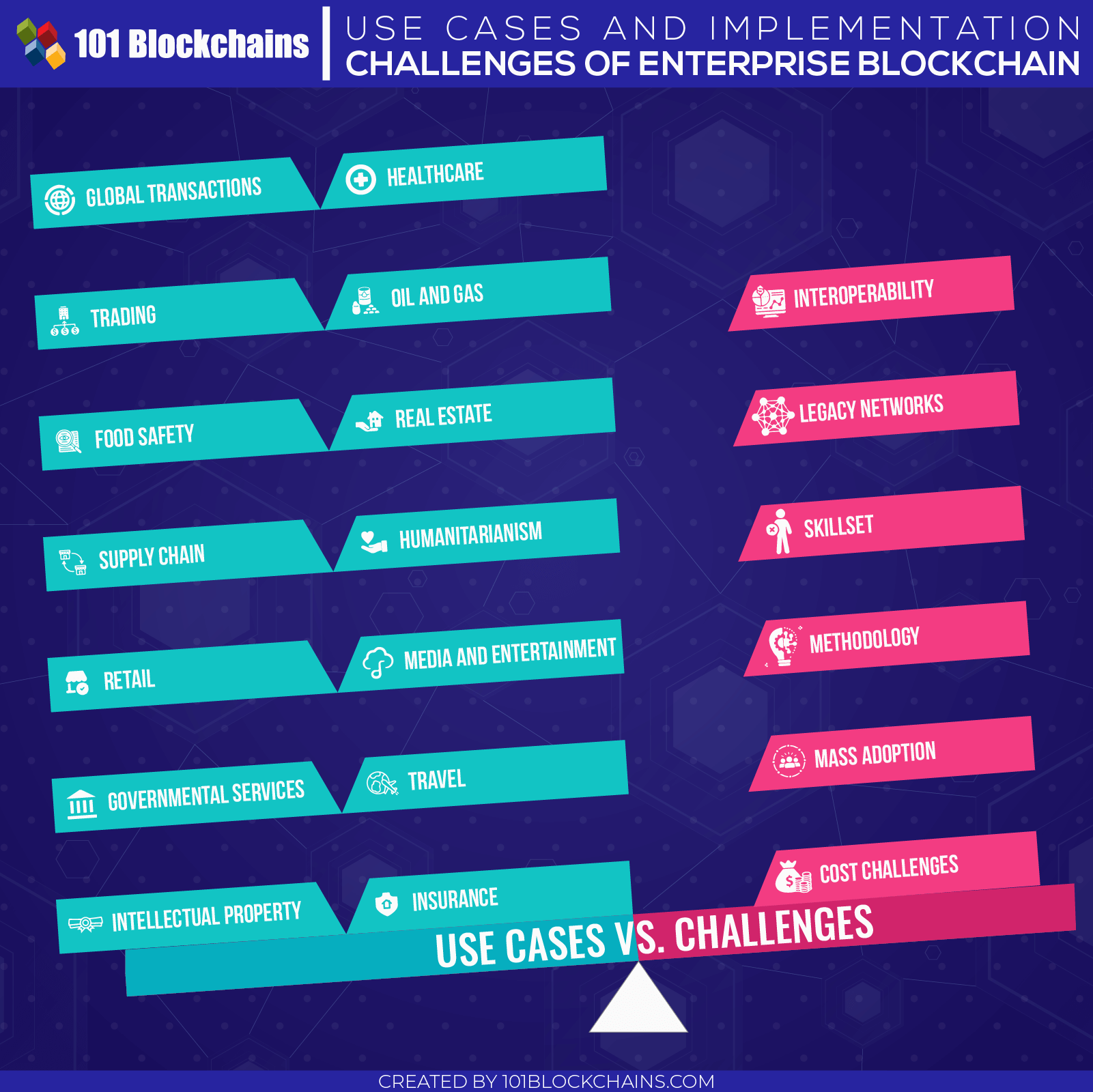
Please include attribution to 101blockchains.com with this graphic. <a href='https://101blockchains.com/blockchain-infographics/'> <img src='https://101blockchains.com/wp-content/uploads/2019/03/Use-cases-and-implementation-challanges-of-Enterprise-Blockchain.png' alt='Use cases and implementation challanges of Enterprise Blockchain='0' /> </a>
-
Global Transactions
Let’s start with global transactions as it’s one of the most prominent enterprise blockchain use cases. Banking sectors or financial sectors are the first ones to look into blockchain for enterprise. These sectors deal with a typical flaw – the centralized architecture.
But blockchain for enterprise can provide instant transactions even in cross border payment environments along with getting rid of corrupted personals. So, it’s a massive win for financial sectors.
-
Trading
Another popular enterprise blockchain use cases are the applications in trade finance. Every year more over $18 trillion worth of goods are shipped. But these companies need more control to fight the counterfeit goods on the market.
And blockchain for enterprise can easily solve the problem higher efficiency, tracking, reduced costing and paperwork.
-
Food Safety
Obviously, you and everyone else is concerned with the food we consume. Moreover, processed food companies don’t always think about the health issues for the chemicals they use to preserve. And so, blockchain for enterprise can truly shine in this niche.
How?
Well, blockchain for enterprise can trace the raw materials and make sure every food goes by the health regulations. So, using these enterprise blockchain use cases your food industry could bloom easily.
-
Supply Chain
One of the prominent enterprise blockchain use cases is the supply chain. The supply chain is a massive part of our industrial ecosystem and blockchain for enterprise can help here too –
- Offering a ledger system that can track the products.
- Validating data and secure payment through Smart Contracts.
- Accurate information to fight bad players.
- Increasing revenue.
- Reducing costing.
-
Retail
Retailers are now looking into blockchain for enterprise quite often. It’s because enterprise blockchain use cases in this department can truly upgrade their systems. Tracking and securing retail products, fighting counterfeit are some of the features of blockchain for enterprise.
Moreover, small-time retailers can shine as the ledger will provide a fair play for everyone. So, big giants taking up all the customers won’t be an issue here.
-
Governmental Services
Governmental service is a massive sector, to begin with. These sectors are falling behind when technology is blooming exponentially. To keep up with it, they can use blockchain for enterprise. Enterprise blockchain use cases are fairly diverse and suited for governments also.
A secure ledger can preserve all sensitive information to get rid of paper trails, preserve human rights and offer digital IDs. These are just a few of the use cases. We’ll talk more about it a bit later.
-
Intellectual Property
Intellectual property management is a huge sector because they need to manage to patent along with trademarking. Without these sectors, any community such as musicians, designers, artists or inventors won’t get credit for what they achieved.
Blockchain for enterprise can help them get the proper value they deserve as well as preserve their patented goods from leaking. That’s why this is another great one in the enterprise blockchain use cases list.
-
Healthcare
Healthcare and even Pharmaceuticals can use blockchain for enterprise to outshine in this field. Many countries already invest a ton of money but with little outcome. It’s because of the lack of proper security and transparency. Another major concern is the counterfeit drugs, and these have extended health issues.
To fight all the problems they can leverage enterprise blockchain use cases here. With a secure platform and transparency now they can track their drugs and also give patients the right to their medical records.
We’ll talk more about this sector briefly.
-
Oil and Gas
The industry of Oil and Gas can highly benefit from blockchain for enterprise architecture. Moreover, it can increase efficiency by calculating all the possible routes for shipment. So, taking the best route will reduce costs.
Moreover, the typical model isn’t that much accurate, but leveraging enterprise blockchain use cases, they can increase 5% more revenue.
-
Real Estate
The present real estate market isn’t doing that well. It suffers from some huge issue like inaccessibility, greater costs, and poor liquidity. It’s becoming more of a luxury product for rich people only. If the industry wants to balance it, they need to look into blockchain for enterprise.
The technology can offer liquidity and offer fractional ownership that will be within reach of middle classes too.
-
Humanitarianism
Blockchain for enterprise can leverage all the features in this sector effortlessly. Usually, a humanitarian project deals with bad players.
To fight the corrupted environment, they can leverage enterprise blockchain use cases to track the donations. Therefore, they can offer 100% efficiency for the donators to see if the money is going to a helpless person or not.
-
Insurance
Insurance is another popular sector in case of blockchain for enterprise. Using blockchain for enterprise the insurance company can benefit both their customers and themselves. An insurer and customer always has to deal with a heap load of paperwork.
But if they use a smart contract to highlight the rules, then the process would become much simpler. They can streamline any insurance claim automatically.
-
Media and Entertainment
Now media and entertainment don’t all reside in television. The sectors evolved and now uses online platforms to promote their work. However, these platforms don’t always play fair games. And so, many artists don’t get the compensation they deserve.
But with blockchain for enterprise they can promote a decentralizing structure and get their fair share of value.
-
Travel
Many airports are now looking into enterprise blockchain platform as it can be the best solution to an internal networking model. Passenger processing takes up a lot of time in the airports, and if they can streamline it, the overall efficiency would skyrocket.
If they can use fewer documentations and more biometric authentications, then even fugitives would not be able to travel on air.
Implementation Challenges
Implementation challenges are the major hurdle to utilize all the use cases above. All the use cases seem quite lucrative, doesn’t it? But can the challenges overwhelm these use cases? Let’s take a look!
-
Interoperability
The first issue is interoperability. It’s one of the absolute needs when it comes to blockchain for enterprises. Now everything we use is connected, and it streamlines all our tasks quite an efficiency. But if we want to use a completely new type of enterprise blockchain technology, then we need to have interoperability.
If the enterprise blockchain solutions can communicate with each other, then we can create a different networking ecosystem. But unfortunately, enterprise blockchain technology still doesn’t have good enough interoperability.
-
Legacy Networks
Another enterprise blockchain adoption challenges are the existing legacy network. All of our businesses already have a network system that we depend on. Even though these models aren’t efficient enough, still many bog organizations are using them, mostly banks.
That’s why implementing or changing these legacy networks would need time and investments that many aren’t willing to do.
-
Skillset
Implementing enterprise blockchain solutions isn’t an easy job. It takes time and moreover, it needs skilled persons that can develop the enterprise blockchain technology efficiently. But in the marketplace, this level of skillset is rare.
Not many developers can create a complex blockchain model. Moreover, even if they try perfecting it takes up a lot of time. So, you’d always need to have skilled coders that can back up your projects.
-
Methodology
Lack of methodology is a big hurdle in terms of blockchain for enterprise. Many want to develop new projects that might seem like a great idea. But without a proper methodology, they can’t execute it efficiently, which lead to loopholes.
There have been many cases, where loopholes in the code create a security flaw in the network. And these cases make it more difficult for enterprise blockchain technology to get global recognition.
-
Mass Adoption
It’s connected to scalability. If everyone starts to use these networks that mean the network should be capable of handling the mass adoption phase. But even though it seems theoretically possible, many can’t offer fast performance when mass adoption happens.
Now many new projects are trying to overcome this scenario, and hopefully, we will see some possible results soon.
-
Cost Challenges
As we said earlier in case of removing or replacing all legacy network needs time and investment. Investment in this regard could take up a lot of money. The costing of the blockchain for enterprises depends mainly on your requirements.
So, few features and common features would be able to reduce the costs. But implementing new features or exotic features might need a bit more money.
These are a few of the important challenges of blockchain for enterprises so far. We’ll talk more about the other type of challenges briefly.
What’s the Result?
We think you already know by now that the use cases overwhelm the challenges to a great extent. Yes, enterprise blockchain technology comes with some issues. But the possibility of use cases can be limitless. With innovation, it’s only a matter of time that we can overcome all flaws completely.
Moreover, many big companies are already looking into enterprise blockchain solutions. Let’s take a look at them in the next sections.
Chapter-3: Enterprise Projects in Non-financial and Federated Networks
Non-Financial Enterprises Implementing Blockchain
Many non-financial enterprises are implementing enterprise blockchain technology. Check out these top 20 examples of those enterprises.
Enterprises Which Are Implementing Blockchain Technology Infographic
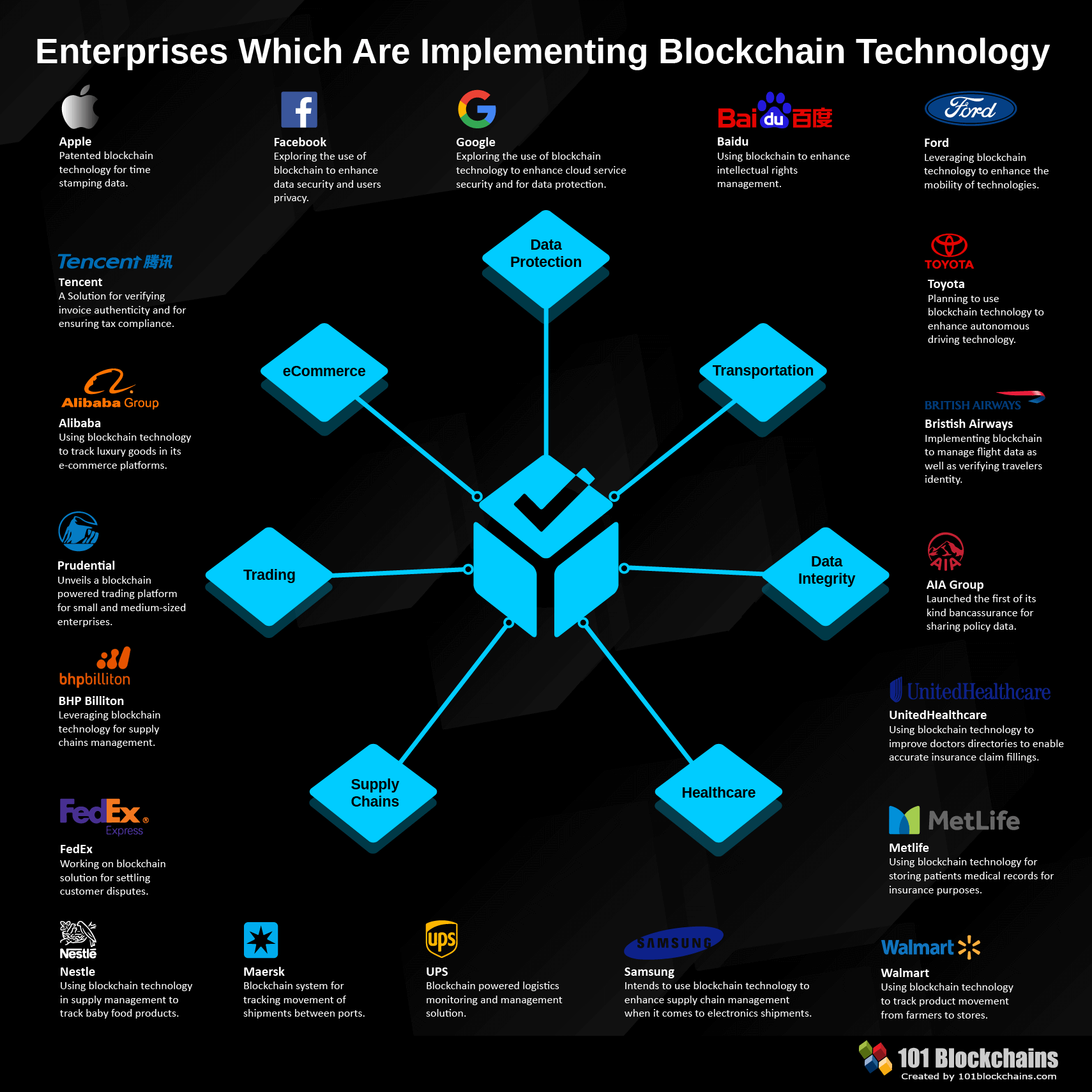
Please include attribution to 101blockchains.com with this graphic. <a href='https://101blockchains.com/blockchain-infographics/'> <img src='https://101blockchains.com/wp-content/uploads/2018/09/Enterprises_Whic_Are_Implementing_Blockchain.png' alt='Enterprises Implementing Blockchain Technology='0' /> </a>
1. Walmart: Product Tracking
The retail giant Walmart is collaborating with IBM to take the lead in enterprise blockchain adoption. Moreover, Walmart is using the features of blockchain for enterprise networks to track products and manage them from day to day operations.
2. Metlife: Automated Insurance Solution
Automated insurance combined with healthcare could be a perfect solution for the most annoying issue. Also, Metlife is implementing an enterprise blockchain adoption to provide this feature to women who are struggling with gestational diabetes financial protection.
3. UPS: Logistics System
United Parcel Services is long for a blockchain powered logistics system. That’s why they joined the Trucking Alliance, and along with them, they are implementing the solution.
4. Toyota: Enhance Autonomous Driving Technology
Teaming up with MIT Media Lab, the auto giant Toyota is implementing enterprise blockchain adoption to enhance autonomous driving technology. Furthermore, using the platform, the users can manage ridesharing information along with car transactions.
5. AIA Group: Bancassurance
Insurance giant AIA Group is implementing blockchain for enterprise solution where they will launch blockchain powered Bancassurance. Furthermore, it will reduce the processing time and increase transparency.
6. BHP Billiton: Supply Chain Management
Mining giant BHP Billiton wants to manage their supply chain process and therefore implementing blockchain for enterprise solutions. They will use the platform to trace and record the wellbore fluid and rock samples.
7. Alibaba: Tracking Luxury Goods
Alibaba is tracking its luxury goods using the enterprise blockchain adoption. Here, they will use enterprise blockchain technology to offer 100% customer satisfaction.
8. Tencent: Legal Billing and Taxation
Tencent is working on enterprise blockchain adoption to make sure that the taxation and legal billing in the Chinese city of Shenzhen. Is more efficient. They can reduce the costing and combat fake invoices.
9. Baidu: Intellectual Rights Management
Search giant Baidu wants to offer a great solution for photographers. Furthermore, they are implementing a blockchain for enterprise project that will preserve the image rights of the photographers.
10. Ford: Support Mobility Technologies
Ford is the recent addition to automotive companies who are using enterprise blockchain solution. The company wants to implement this platform to support their mobility technology because they have smart mobility solutions.
11. British Airways: Monitoring System
Using VChain’s Verification Service the British Airways are experimenting with enterprise blockchain adoption to create a blockchain monitoring system. Mainly they want to monitor flight information in Geneva, Miami, and London.
12. Facebook: Data Management and Protection
What better way to ensure better protection of people’s data than to use blockchain? Facebook is looking into blockchain technology to change its internal structure of the network and make it more secure for people to use their platforms instead of their data getting stolen.
13. Walt Disney: Track Inventories
Enterprise Blockchain adoption within Walt Disney is also on track. Furthermore, they want to use the platform to track their inventories of shipments and sales in the park.
14. Maersk: Shipping Platform
You must know Maersk, one of the world’s largest shipping companies. They teamed up with IBM to create a shipping platform that will monitor their shipments of cargo. TradeLens is the main executioner of implementing the platform to track the shipments.
15. Prudential: Trade Platform
Trade platforms in blockchain isn’t a new subject. But Prudential is working with Starhub to create a trading platform for medium to small enterprises. So, using the platform, they can connect more businesses and give them the option to make payments too.
16. Apple: Timestamp Data
Apple wasn’t so eager about blockchain for enterprise from the start but and they did not even say anything in this matter. But reportedly, now they might be looking into it for possible timestamping data solutions.
17. Nestle: Supply Management
Nestle is trying to offer better value with enterprise blockchain adoption. Furthermore, they will be using the platform to track food products starting from the farms so that people get the best quality foods.
18. UnitedHealthcare/ Quest Diagnostics /Optum/ Humana: Improving Doctors Directories
UnitedHealthcare, Quest Diagnostics, Optum, and Humana are implementing blockchain technology to increase efficiencies in doctor directories. Usually, healthcare sectors deal with inaccurate doctor directory issues. But with their solution, they can finally set it right.
19. Samsung: Supply Chain Management
Samsung finally implemented their enterprise blockchain adoption to track supply chain management. Well, it was high time for them to look for solutions to manage their enormous supply chain process.
20. FedEx: Disputes Settling
Blockchain technology can streamline the process of settling customer disputes in FedEx, so they are looking into blockchain for enterprise to integrate the system
Federated Networks
During the last three years after massive efforts, federated networks finally started to bloom. There are so many projects that are using Hyperledger or R3 Corda as their core blockchain platform to create federated networks.
Let’s check these networks out and see who are in this federated networks.
Federated Blockchains Ecosystem Infographic
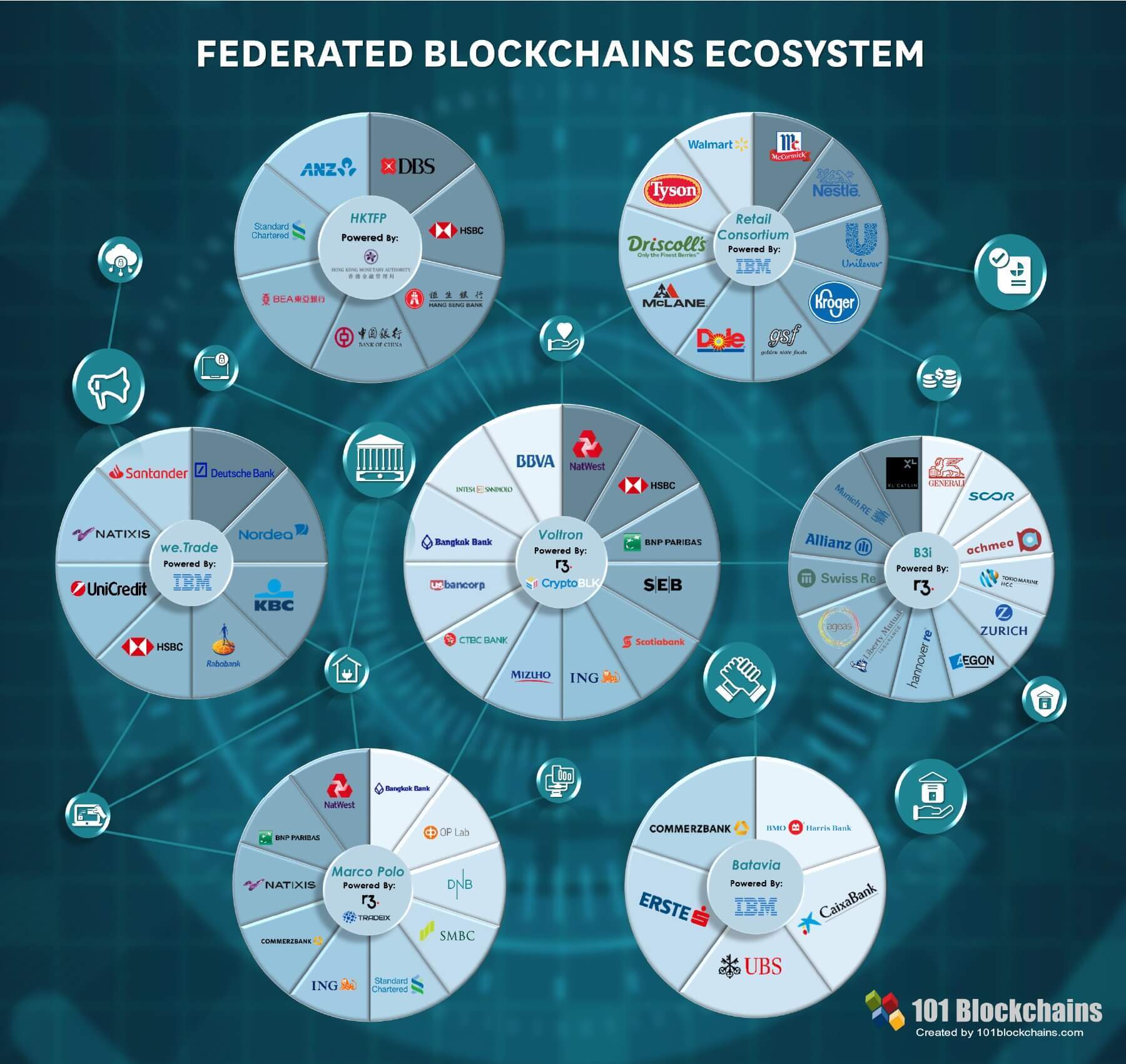
Please include attribution to 101blockchains.com with this graphic. <a href='https://101blockchains.com/blockchain-infographics/'> <img src='https://101blockchains.com/wp-content/uploads/2018/10/federated_Blockchain_ecosystem.jpg' alt='Federated Blockchains Ecosystem='0' /> </a>
-
Voltron
This is a wonderful blockchain for enterprise project powered by – CryptoBLK and R3. For tech support, they are using Microsoft’s cloud platform called Azure. Voltron is a product of twelve banks forming the federated blockchain for enterprise.
These are –
ING, Mizuho, Intesa Sanpaolo, Scotiabank, BNP Paribas, BBVA, Natwest, CTBC bank, Bangkok Bank, U.S Bank, HSBC, and SEB.
In this blockchain for enterprise project, Voltron will be using the platform Corda to digitize all the documentation of the banks. Banking sectors are now more than eager to work with enterprise blockchain technology. With Voltron now banks can cut down the manual labor of paperwork processing and can fully utilize all the features.
-
Marco Polo
Another awesome collaboration of R3 is the federated network Marco Polo. In Marco, Polo R3 is collaborating with TradeIX, and here ten popular financial organizations are coming together under one platform.
These are –
OP Financial, SMBC, Standard Chartered, Commerzbank, Natixis, DNB, ING, NatWest, Bangkok Bank, and BNP Paribas.
Additionally, Marco Polo will be using TradeIX’s Core TIX and R3’s Corda platform for this blockchain for enterprise project. TIX Core is another type of DLT like Corda. Moreover, the main aim of this enterprise blockchain platform is to track the process of the payments and offer higher security for the receivable discounts.
-
Batavia
Even though Batavia is a small blockchain for enterprise project but still it has a lot to offer. Batavia wants to use blockchain for enterprise to implement smart contracts in all the possible financial institutions.
The enterprise blockchain solution will be able to offer cross-border trading as well.
The banks under this federated blockchain are –
CaixaBank, Commerzbank, Bank of Montreal, UBS, and Erste Group.
-
Trade
This platform wants to target the Europe region and wants to provide an invoice factoring. Moreover, they are using smart contracts which lets them factorize quite effortlessly. They currently have eight banks under their blockchain for enterprise platform; however, they want to add Societé Generale in the federated network as well.
These are –
Deutsche Bank, Natixis, Nordea, Santander, KBC, Rabobank, UniCredit, and HSBC.
-
Hong Kong Trade Finance Platform (HKTFP)
Hong Kong Monetary Authority is taking the lead in this federated enterprise blockchain platform. For the root of the platform, they are using technology from Ping An Group. Additionally, they have 21 banks in this enterprise blockchain solution but we only a few names so far.
These are –
Bank of China, Standard Chartered, ANZ, Hang Seng Bank, Bank of East Asia, DBS and HSBC.
Using the HKTFP platform every company wants to digitize the process of supply chain management and store all the information on the blockchain for enterprise platform to safeguard them.
-
Retail Consortium
At present, they still don’t have any official name for this federated network project, but we do know that IBM is collaborating with global retailers to form this platform. Additionally, the retailers will use IBM’s platform Hyperledger Fabric to use as the base of their blockchain for enterprise network.
The main goal of the network is to offer greater value to the customers. Each year many people suffer for contamination in the retails food products. So, to reduce these, ten companies are coming together.
These are –
Driscoll’s, Unilever, McLane Company, Nestlé, Kroger, Dole, McCormick and Company, Walmart, Golden State Foods, and Tyson Foods.
If they make it happen the new formation would change the food ecosystem for good.
-
B3i
R3 strikes another collaboration again. B3i is powered by R3’s Corda platform. Here, all the insurance documentation will get digitized using the DLT platform. The main reason is that all the insurance company wants to streamline the services they offer and provide a better output for the customers.
Thirteen banks are coming together to make this blockchain for enterprise project successful.
They are –
Tokio Marine, SCOR, Zurich Insurance Group, Liberty Mutual, Allianz, Achmea, Generali, Munich Re, XL Catlin, Hanover Re, Ageas, Swiss Re, and Aegon.
Chapter-4: Enterprise Blockchains: BAAS Vendors and Popular Platforms
You should be already familiar with the big software giants in the market. Some of the most recognized names are taking part in this new major ecosystem. Let’s take a look at what they are –
BAAS Providers
1. Oracle
One of the most popular vendors on the market is Oracle. Oracle is providing a comprehensive DLT for all enterprise users. In their solutions, you’ll be able to start your blockchain implementation and also update it from time to time.
Moreover, Oracle will let you share information with multiple persons such as your supplier, business partner or customers in a reliable environment. This platform will use composable architecture model. The model will help you implement any special kind of feature geared solely for your needs.
Read More – Blockchain Oracles: Know About The Fundamentals
2. IBM
IBM is another popular BAAS provider for enterprises. Their IBM Cloud infrastructure offers a fully integrated, functional and enterprise-ready BAAS solution. At present they are only offering Hyperledger Fabric solutions as they collaborated on this project.
With the platform, you’ll find it much easier to govern, develop or even operate it. Whatever your demands may be, IBM will craft up the services for you. Integrating with existing network system is super-fast that promotes performance, privacy, and security.
Examples of Baas Vendors and Enterprise Blockchain Platforms Infographic
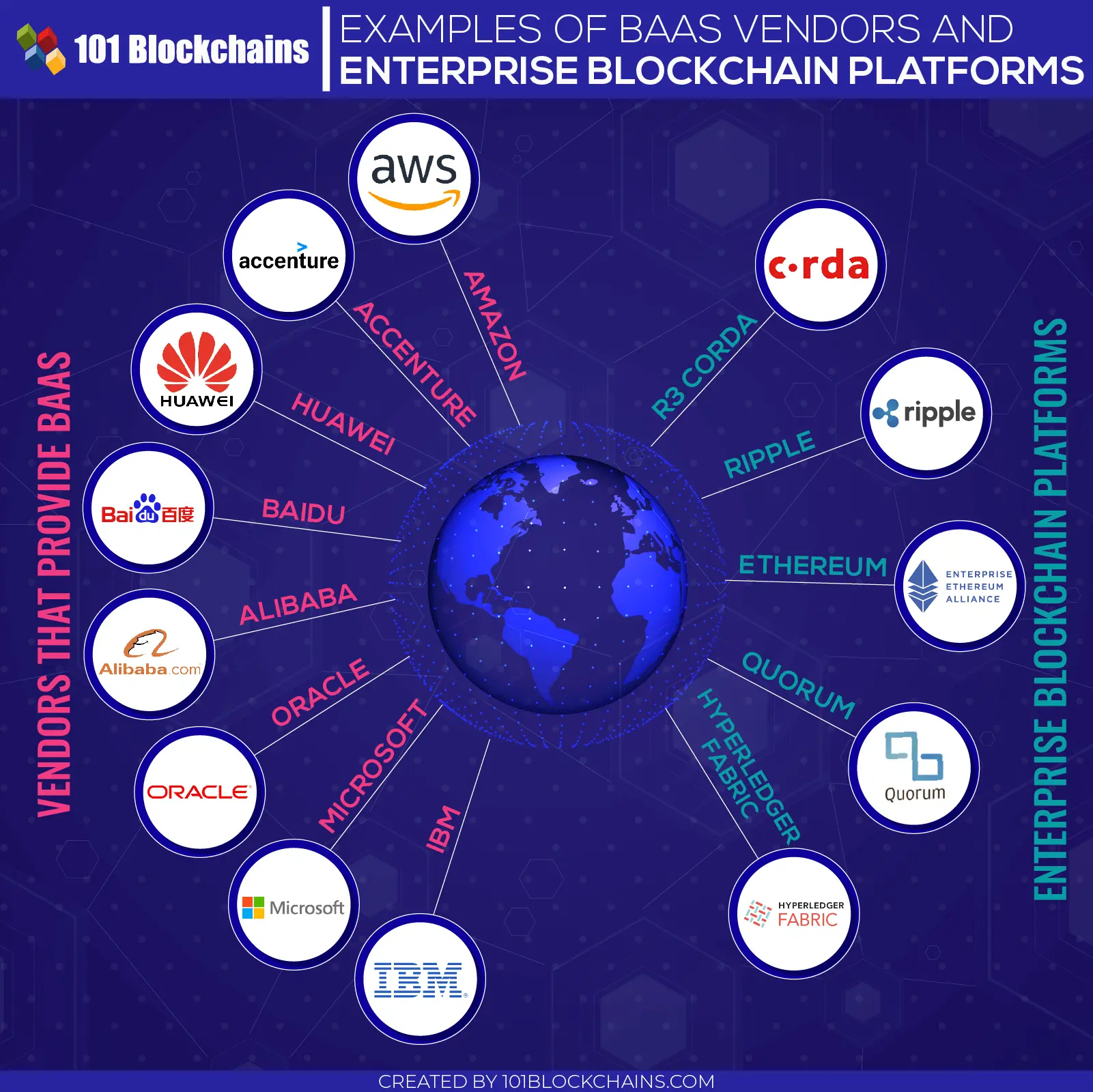
Please include attribution to 101blockchains.com with this graphic. <a href='https://101blockchains.com/blockchain-infographics/'> <img src='https://101blockchains.com/wp-content/uploads/2019/03/Example_of_baas_vendors_and_enterprise_blockchain_platforms.png' alt='Example of baas vendors and enterprise blockchain platforms='0' /> </a>
3. Amazon
This one is another popular enterprise blockchain solution as AWS would give you the simplicity you want. With Amazon Web Services, you’ll be able to create your very own enterprise blockchain solutions and grow your company.
The best part about this enterprise blockchain solution is that they offer fully managed networks. This means if you have the time or workforce to foresee your network, then Amazon will do it for you. All of their solutions are easy to set up, and moreover, they aren’t costly either.
Want to learn all the fundamentals of Blockchain as a Service? Enroll Now – Getting Started with AWS Blockchain as a Service (BaaS)
4. Microsoft
You already know the tech giant Microsoft, and they are here with their fair share of BAAS solutions. Microsoft Azure is becoming more and more popular as an enterprise blockchain solution, as with this you can create new platforms and start using it within a day!
Most importantly, if you want to develop a new project of yours, then Azure can give you all the necessary tools you need. It’s more suited as a Workbench instead of a ledger system. So, if you are worried about your budget, then you should check them out as they offer one of the lowest rates in the market.
5. Alibaba
The Alibaba Cloud might just be the next best enterprise blockchain solution on the market. Whatever kind of blockchain solution you want you can get it from them. Maybe you love all the flashy popular enterprise platforms on the market. Don’t worry; Alibaba has your back.
Maybe you are a busy person and need to focus more on your business rather than a blockchain platform. But how will you do it? Simple, let Alibaba Cloud deploy, operate and maintain the platform, and you focus on the growth of the business.
6. Baidu
Maybe you want a different kind of solution, something faster, more scalable. Well, Baidu just might be that enterprise blockchain solution. They offer a new kind of platform that can cover a wide range of fields such as IoT, food safety, supply chain, finance, healthcare and many more.
Moreover, if you have a business where you need to deal with a lot of transactions, then Baidu’s Xuper Chain can offer you more than 10,000 transactions every second.
7. Huawei
The company Huawei joined the league of enterprise blockchain solution just recently. In early deployment, they opened their services only for the China community. But later they opened it up globally.
Their platform Huawei Cloud offers Hyperledger Fabric, and with that platform, you will get all the tools Hyperledger offers. It’s easy to start the process, need only a few minutes to deploy the solution. Moreover, it can transact 5000 transactions per second.
8. Accenture
One of the forefront runners of the blockchain economy is Accenture. Accenture always showed a great deal of interest in blockchain right after people started to see the new technology. Now they also offer BAAS services to provide enterprise blockchain solutions.
Moreover, if you are confused with the platform or need consultancy on how you can use blockchain in your company, they will give you advice. They can offer their expertise to promote the best features you’ll ever need in the platform.
Enterprise Platforms
These enterprise platforms have a fair deal of popularity in the blockchain marketplace. Check out these popular examples.
-
Hyperledger
Let’s start with Hyperledger as they are thriving as a company. They only started their journey back in 2015 and slowly became the cross-industry open source of heaven for companies. All of their solutions have multipurpose industry integrations. But you’ll be glad to know they boast about their modular enterprise blockchain platform.
So, you can just plug in the feature you want and start using the platform. Moreover, they have multiple collaborations, and they always keep track of all their projects.
-
Ethereum Enterprise Alliance
If you are looking for a mature enterprise blockchain platform, then it’s a must to check out Ethereum Enterprise Alliance. This blockchain for enterprise platform offers some of the most robust platforms out there. The platform comes with advanced usability and functionality.
So, whatever your company may be dealing with, EEA can always help you out. This enterprise blockchain got over 250+ members under their bags with 500 more startups linking back to them. It’s also a permissionless platform.
-
Corda
R3’s enterprise blockchain platform Corda is a commercial version of that platform. The open source platform is suited explicitly for financial use cases; however, R3 claims the platform can be multi-purpose integrated.
Maybe you are looking for a quality and a good network infrastructure then it’s time for you to definitely check out Corda. Corda can act as the supreme firewall of safety along with providing scalable solutions.
-
Ripple
Safety issues and security protocols are the two most important factors of this enterprise blockchain platform – Ripple. Ripple started their journey a bit early with a different name, right in 2012. But after a few years in 2015, they renamed it.
With their platform RippleNet, you could get an almost free global payment platform. If you are a financial institution, then Ripple just might be your best bet as they can settle your transactions within 4 seconds!
-
Quorum
The platform Quorum is the brainchild of J.P. Morgan. However, he used Ethereum as the root model, with some tweak to make it more suitable for enterprise use cases only. Moreover, it’s designed to handle a greater load within a short amount of time.
So, even if your company has to deal with a lot of busy hours, Quorum might just be able to help you out. But why is it that fast? Well, Quorum doesn’t follow the traditional ways of blockchain where they use consensus algorithms. But it uses voting or some form of lighter algorithms to reach the agreements. That’s why it’s so fast.
Chapter-5: Hyperledger Ecosystem
BAAS Vendors of Hyperledger
Hyperledger is truly a champion when it comes to blockchain for enterprise. They already have a lot of solution specifically geared for any kind of institution. They have the cooperation of many vendors. Furthermore, all the vendors offer Hyperledger platform solution at cheap pricing, but they have a lot of things going on. These are few of the popular ones –
- Accenture
- IBM
- Alibaba Cloud
- Oracle
- Microsoft Azure
- Samsung SDS
- AWS
To know more about these vendors check out our blockchain for enterprise pdf and enterprise blockchains ppt.
Hyperledger Ecosystem Infographic
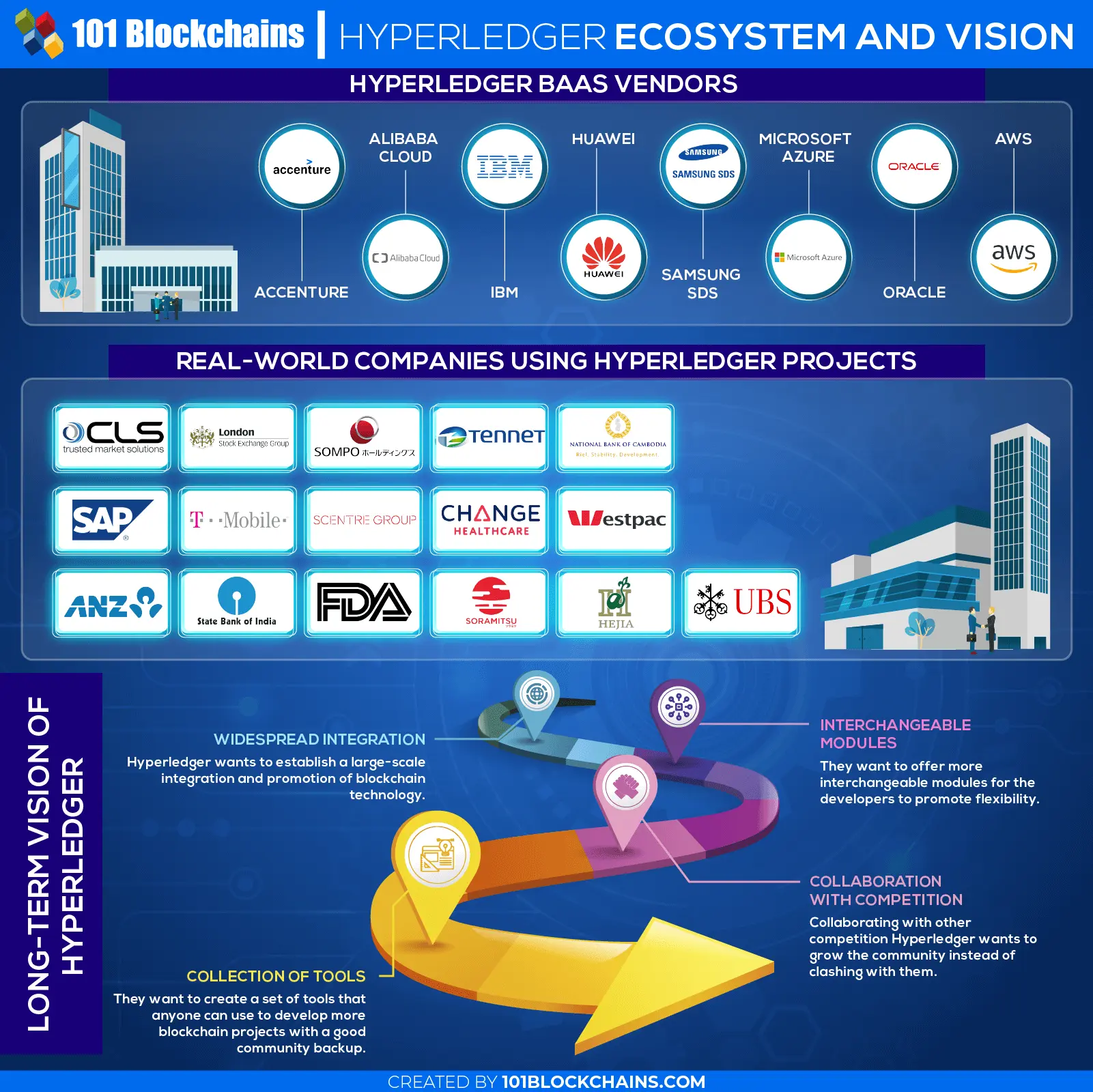
Please include attribution to 101blockchains.com with this graphic. <a href='https://101blockchains.com/blockchain-infographics/'> <img src='https://101blockchains.com/wp-content/uploads/2019/03/hyperledger_ecosystem.png' alt='hyperledger enterprise blockchain='0' /> </a>
Real-World Companies Using Hyperledger Projects
Many companies now use Hyperledger projects to satisfy their needs. They are also the part of Hyperledger ecosystem. Let’s see what these companies are –
-
CLS
CLSNet gets power from Hyperledger Fabric. It’s a payment netting solution to reduce risk.
-
U.S. Food and Drug Administration (FDA)
FDA is securing healthcare data suing blockchain. At present they are relying on the Hyperledger Fabric framework. This healthcare records could cover genomic data, EMRs, clinical trials, etc.
-
Sichuan Hejia Co. Ltd.
The Yijian Blockchain project of Hejia comes with a bank, a pharmaceutical retailer and a hospital. They are collaborating to stop financial challenges using Hyperledger Fabric.
-
London Stock Exchange Group
London Stock Exchange Group is using Fabric to create a financial business network. Interoperability within their systems is the top priority of the project.
-
TenneT
TenneT wants to use Hyperledger Fabric to provide a constant supply for electricity using idle car batteries and generators of the common people.
-
SAP
Another wonderful Hyperledger Fabric use cases are the cloud platform of SAP. They want to offer this platform to develop blockchain applications.
-
ANZ, Westpac and Scentre Group
ANZ, Westpac, and Scentre Group have teamed up on a blockchain project. Here, they are using Hyperledger Fabric to digitize the bank guarantee processes for property leasing. The aim is to eliminate the paper-based banking system to reduce fraudulence.
-
UBS
UBS along with other companies are using Hyperledger Fabric to power their trade platform consortium Batavia.
-
Change Healthcare
Change Healthcare is using Fabric to fuel its Intelligent Healthcare Network™. This network offers claims management transparency. Using this they can track the status of claims submission and remittances.
-
National Bank of Cambodia
Bakong is a banking system that runs on Hyperledger Iroha. National Bank of Cambodia wants to offer a financial system for managing assets for all the banks within Cambodia.
-
Sompo Japan Nipponkoa Holdings Inc.
Sompo Japan is using Hyperledger Iroha to manage weather derivative contracts.
-
Soramitsu
Soramitsu is using Hyperledger Iroha to offer solutions for businesses to manage their digital assets. However, they are the original developer of this Hyperledger project.
-
T-Mobile
T-Mobile created the Sawtooth Hyper Directory using Hyperledger Sawtooth to provide Access and Identity management solutions.
-
State Bank of India
State Bank of India is using Hyperledger Sawtooth in a consortium of banks named as BankChain to implement KYC/AML protocols.
Chapter-6: Blockchain in Healthcare and Government
Blockchain for Healthcare
The current blockchain trend is serving the healthcare industry in many ways — better supply chain, resolving drug counterfeit, improved data storage, and security. Blockchain for enterprise can actually save lives. But how? Let’s see how the healthcare industry is really shining due to blockchain for enterprise.
Blockchain For Healthcare Infographic

Please include attribution to 101blockchains.com with this graphic. <a href='https://101blockchains.com/blockchain-infographics/'> <img src='https://101blockchains.com/wp-content/uploads/2019/01/blockchain_for_healthcare.png' alt='Blockchain For Healthcare: Use Cases And Applications='0' /> </a>
Challenges of the Current Healthcare System
-
Drug Counterfeit
The supply chain of healthcare deal with one of the worse challenges of all. Drug Counterfeit is taking the toll on the healthcare industry. Without the lack of proper supervision, many drugs get counterfeited every year.
Around 10%-30% of the drugs get counterfeited, and many people fall sick every day. Right now, the counterfeit drug market is more than $200 billion annually. It means close to 1/3 of the drugs supplied drugs are fake.
-
Data Segmentation
Another challenge in this industry is the data segmentation issue. Usually, much critical information such as patient data gets scattered all around the network. And so, when needed no one can find the right information at the right time.
So, when the physicians need to learn about the patient’s history, he/she can’t get all the info at once. Thus, doctors fail to give the patient the necessary treatments.
-
Poor Management
The management system of the healthcare industry is not up to the mark. They fail to offer an efficient system where everything would be streamlined.
-
Healthcare Security and Data Storage
There is a lot of time when someone misuses the valuable information about healthcare data. Moreover, selling this information to third-party companies’ compromises patients’ privacy. Furthermore, many mislead clinical trial reports with errors.
How Can Blockchain Help
- Offering interoperability between systems
- Providing a higher deal of security
- Needs low maintenance cost
- Provides data integrity
- Offers universal access
Blockchain for Healthcare Applications
Clinical Trials
Blockchain can improve clinical trial monitoring by removing frauds and data manipulation. Using the platform, they can store all the information on the ledger and streamline the output even more. Furthermore, this will improve healthcare by a long shot.
Claim and Billing
The billing process is quite complicated, and it takes up a lot of valuable time. By removing intermediates, blockchain can improve both claim and billing aspects of the healthcare industry. Sometimes bad intermediates tend to bill more than the patients original. So, blockchain for the enterprise will get rid of these bad players.
Drug Traceability
As you already know drug counterfeit is a huge deal. But blockchain for enterprise can offer to timestamp the drugs and transaction to deal with it. It can solve counterfeit by providing time-stamped immutable transactions across the supply chain.
Patient Data Management
Blockchain can be used to store data securely. This improves personalization and on point treatments for patient data management.
Blockchain in Government Services
Governments can use blockchain is in many sectors. Let’s check out what sectors these are –
Blockchain For Government Services Infographic
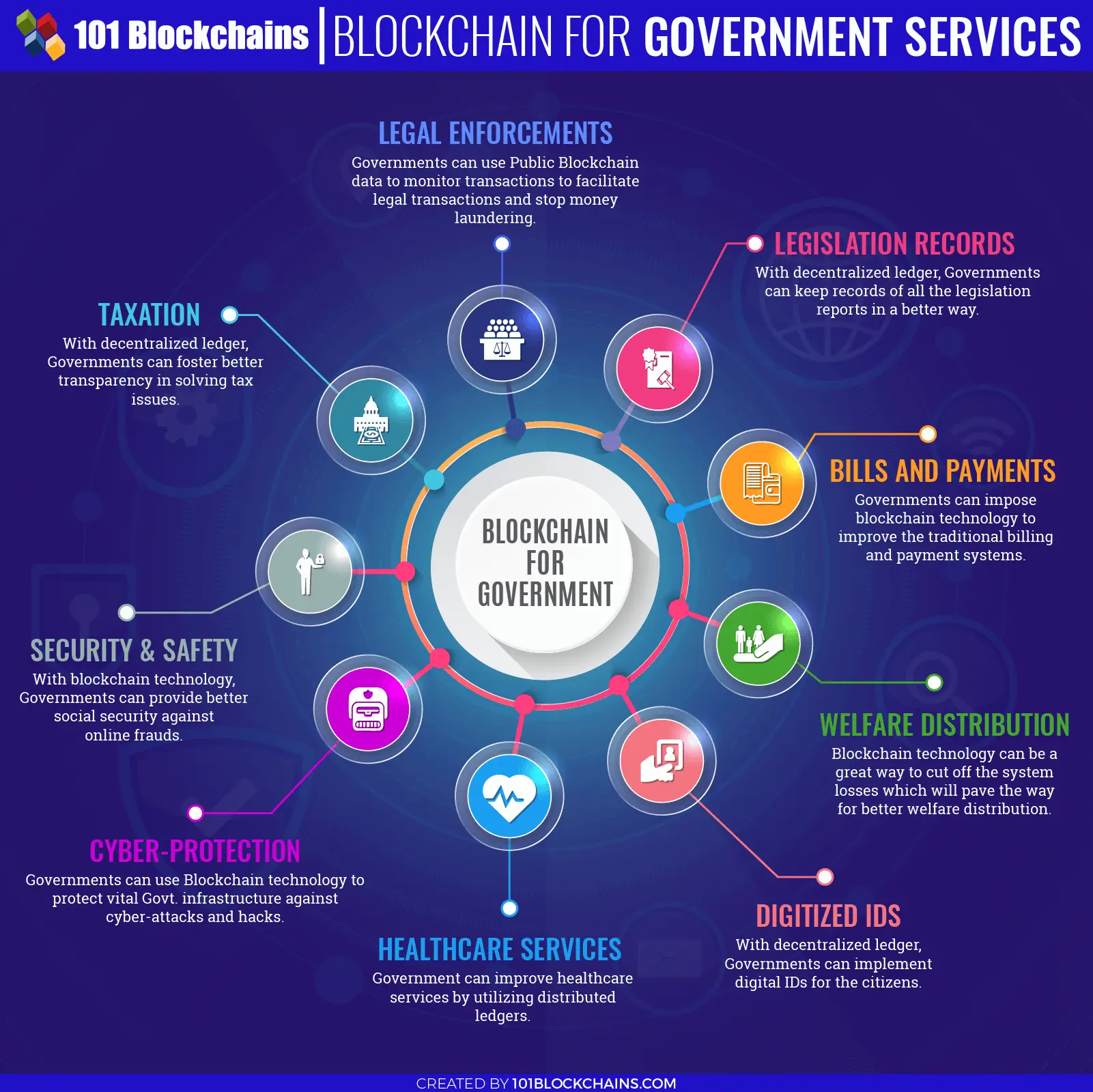
Please include attribution to 101blockchains.com with this graphic. <a href='https://101blockchains.com/blockchain-infographics/'> <img src='https://101blockchains.com/wp-content/uploads/2018/08/Blockchain-for-government-services.png' alt='Blockchain for government services='0' /> </a>
-
Legal Enforcement
If the Governments use public blockchain, they can fight money laundering. Public blockchain will monitor the process of legal transactions and operate whenever they see a bad player.
-
Taxation
Taxation process every year is overly complicated, and many don’t even give taxes as they are supposed to. So, Governments lose valuable tax money every year. To fight this, the Government can use decentralized blockchain for enterprise projects that can offer better transparency.
-
Legislation Records
Legislation records are one of the crucial elements of Government. If they can make it fully digitized, then they can keep records of them in a better way. Moreover, blockchain for enterprise networks can really help here.
-
Welfare Distribution
Welfare projects from the Government suffer from system losses and management. Enterprise blockchain adoption in this can cut off the system losses and offer better welfare management.
-
Healthcare Services
As you already know, the healthcare industry can shine with blockchain and Governments can be the one to introduce this technology to the industry.
-
Digitized IDs
What better way to have blockchain for enterprise networks within Governments to preserve public rights? If the governments can offer digital identification, then ID theft issues will drastically reduce.
-
Cyber-Protection
Government infrastructures have very old networking system that makes it prone to hacks. But they can use enterprise blockchain adoption to fight cyber-attacks.
-
Security and Safety
Social security is a must, but now most of the socialization becomes an online thing. So, the Government can use enterprise blockchain adoption to offer security against online frauds as well.
-
Bills and Payments
Traditional billing method lacks a lot of things such as slow timing, fraudulent activity, lack of transparency and many more. But blockchain can actually solve all the issue.
Government Blockchain Adaptation Example
Already there are many examples of countries that have already started to adopt blockchain technology. Few of these are –
- Switzerland: The city Zug created a new platform called ZugID. This application will let all the citizens of Zug, to get access to e-governance in a secured manner.
- Brazil: The government teamed up with uPort for digital IDs and documentation.
- Estonia: Estonian Government is already suing blockchain technology for their land registry system form 2014.
- Dubai: The country wants to make it fully digitalized using the blockchain technology by 2020.
- India: The Government wants to research how blockchain for enterprise networks can help their businesses grow. Other than there, already many banking sectors are using blockchain.
- UK: England is showing great interest in blockchain for enterprise projects in public sectors.
- S.A: The Government is implementing enterprise blockchain technology both at the local level and federal level.
If you want more information check out our blockchain for enterprise pdf and enterprise blockchains ppt to get a better understating of the Government system.
Chapter-7: Decentralized Internet and Web 3.0
Centralized Internet Transitioning to Decentralized Internet
It’s time to take a moment and go back to why blockchain for enterprise became a fundamental technology. The main reason could be it’s trustless. But that’s not the only reason for it to be so much lucrative.
The technology is shifting most of our current structure of networks, and it’s for the greater good. But how is it changing it?
Let’s take a look at the most obvious example of centralized and decentralized internet. This way you’ll know a bit more about the changes enterprise blockchain adoption is making. But you can find out more with our blockchain for enterprise pdf.
Centralized vs Decentralized Internet Infographic
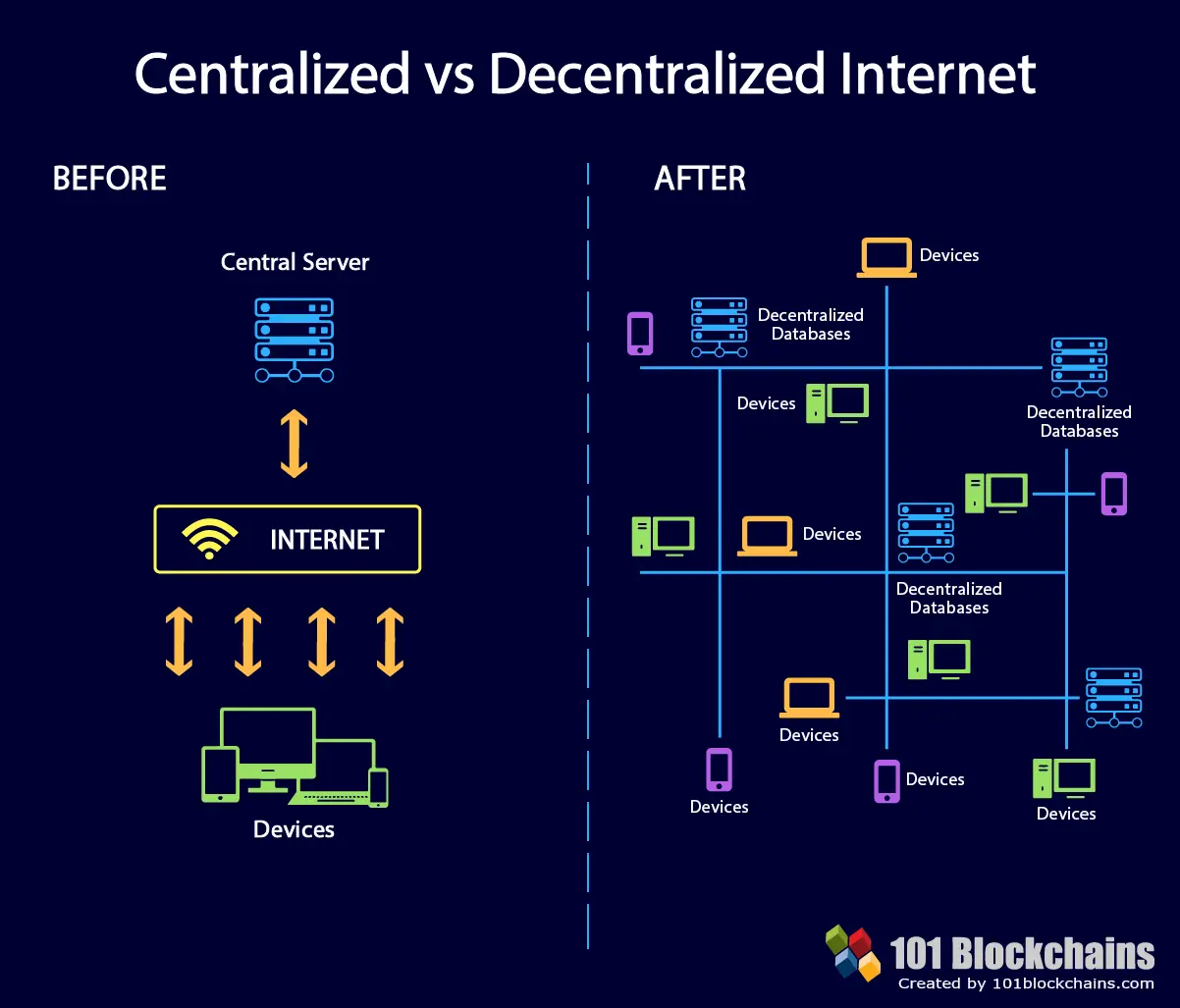
Please include attribution to 101blockchains.com with this graphic. <a href='https://101blockchains.com/blockchain-infographics/'> <img src='https://101blockchains.com/wp-content/uploads/2018/08/From_Centralized_to_Decentralized.png' alt='Centralized vs Decentralized internet='0' /> </a>
Centralized Network
So which network system do you call a centralized network? Typically in a centralized network system, there is a centralized point. In most cases, this point is a server where the data of any network needs to pass through.
After passing through the server, it gets distributed to various kinds of devices or computers. Different servers in various places formed the network we use as the internet. You might know this structure as a client-server model as its super popular and the backbone of today’s internet.
Moreover, you can also find smaller network within a big network. But this structure makes it vulnerable to attacks. For example, any data coming in or going out from the U.S.A will need to use servers. So, if anyone tries they can scan the server for possible data mining.
It’s one of the major issues of a centralized network. Moreover, this structure doesn’t give users any privacy rights. So, hackers can easily swoop in and get ahold of all your personal information.
This is where decentralized internet or networks come in.
Decentralized Network
In this new type of decentralized network system, the connection relies on peer-to-peer. Thus, in a community of people there won’t be any single point of entry but multiple entities are in control. So, instead of a server acting as a host, various other devices can act as a host too.
That’s why if you launch a website the data will spread across hundreds and thousands of devices rather than being in custody of a single server.
Thus, the game of monopoly of a single point of entry is stopped, and every people using the internet would be able to control their data more efficiently.
It’s a new type of business model that can reshape the internet for good with a different data flow.
But to understand it better let’s take a look at the history of web and how it’s evolving so far.
History of the Web: How Web 3.0 Came To Be
The History of the Web Infographic
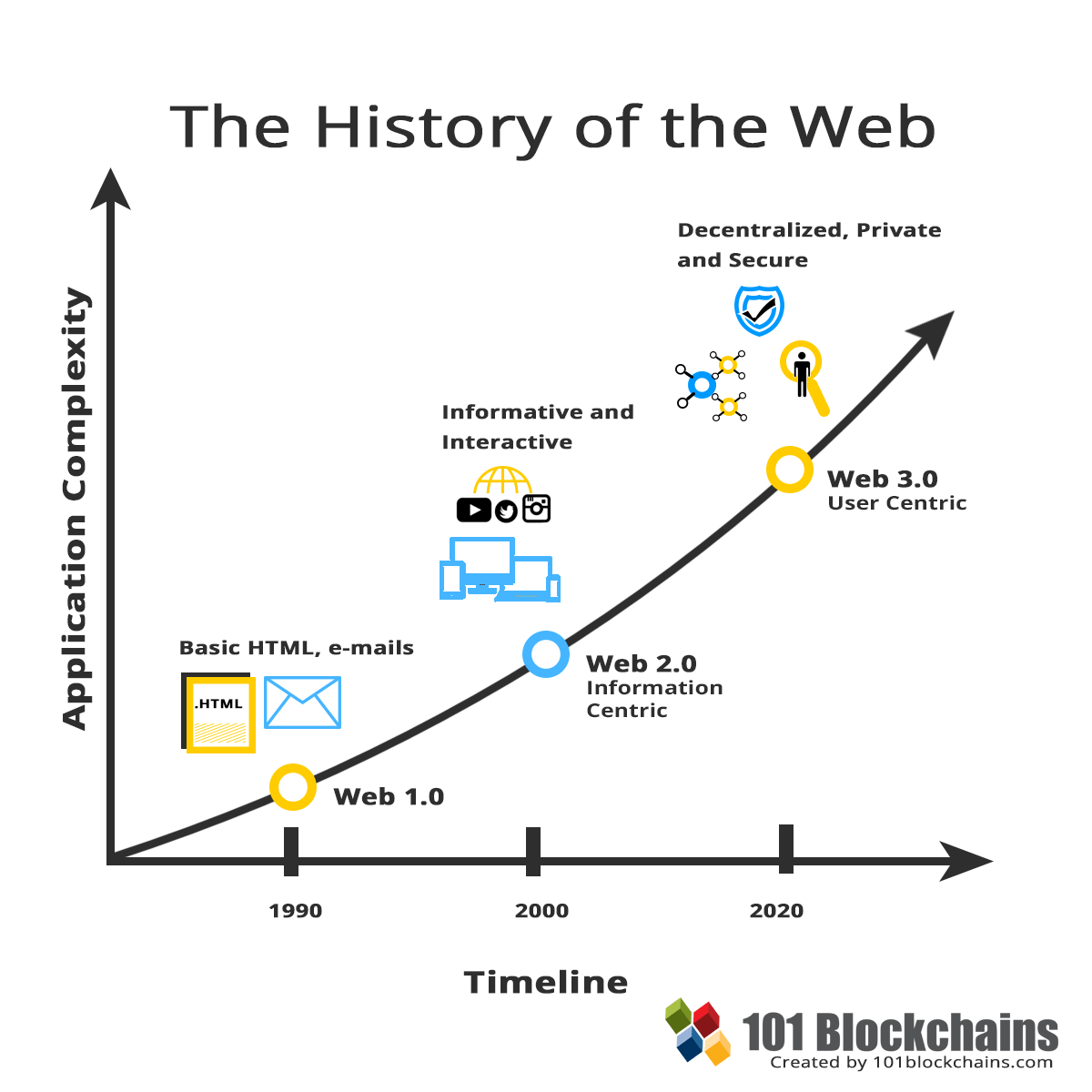
Please include attribution to 101blockchains.com with this graphic. <a href='https://101blockchains.com/blockchain-infographics/'> <img src='https://101blockchains.com/wp-content/uploads/2018/07/History_of_the_Web-1.png' alt='History of the Web 3.0='0' /> </a>
Web 1.0: Where It All Began
You guys should all be familiar with a popular joke where previously people used dial-up internet connections and how it took 100 years to download or upload a 5mb file, right?
Yes, web 1.0 was all about that. It was the primary stage of how today’s internet, worked back then. People would only use the internet for essential communications such as sending emails. Therefore, you would only see the internet in corporate offices and using it for personal entertainment would be out of the question.
Web 1.0 was fairly not interesting at all. Big companies would only create content for people to read. Moreover, the content didn’t connect people; there were no social media. All the websites had monologues structure.
And after some time came the time of plagiarism. Everyone started to copy each other’s content, and it became rare to find a unique one and no algorithm to track or establish copyrights. However, then it started to evolve, and there came the Web 2.0.
Web 2.0: A Time of the Social Revolution
The new Web 2.0 provided benefits for the users much more than the dial-up connection ever could. Now in this version, you can write the data along with reading them. Moreover, Web 2.0 could handle billions of users at once. It came with JavaScript and Ajax based frameworks. Blog started to replace the boring contents of Web 1.0.
With that we also got online gaming, video streaming, listening to music and everything started to shift to online platforms. The web became a place for people to seek knowledge and entertainment, connect with their loved ones.
But what about the future? How will the web of the future be?
Web 3.0: Adding More Value for the People
Web 3.0 can be the next big thing for us. Obviously, it will be decentralized, instead of only writing and reading now the apps could do more. It will offer a semantic searching capability that will give out more accuracy when you search for a thing on the internet.
As it focuses on peer-to-peer connections, you will finally be able to freely use your contents without worrying about any third party stealing it. Our information will be more private and secure. Moreover, there would be no middle man or server to depend on or trust.
Thus, Web 3.0 tries to end the gap between knowledge and technology and make it more accessible to all of us in a connected network.
So, yes, so far it sounds all good, doesn’t it? But we need to overcome some significant challenges. So, we will be going back to the challenges again and talk about new ones that we need to overcome in order for blockchain for enterprise mass adoption.
You will get a more clear idea if you check out our blockchain for enterprise pdf and enterprise blockchains ppt.
So, let’s get on with our next section.
Chapter-8: Top Blockchain Adoption Challenges
We’ve already discussed a few of the enterprise blockchain adoption challenges previously. Now we will shed light on some few more. We can divide the blockchain for enterprise adoption challenges into two main factors – Human and Technology. Both of these have a lot of challenges ahead.
Let’s see what they are –
Human Factors:
- Regulations
- Criminal Connection
- Public Perception
- Skill Set
- Technological Design
Technological Factors:
- Scalability
- Performance
- Energy Consumption
- Privacy
- Security
Top 10 Blockchain Adoption Challenges Infographic
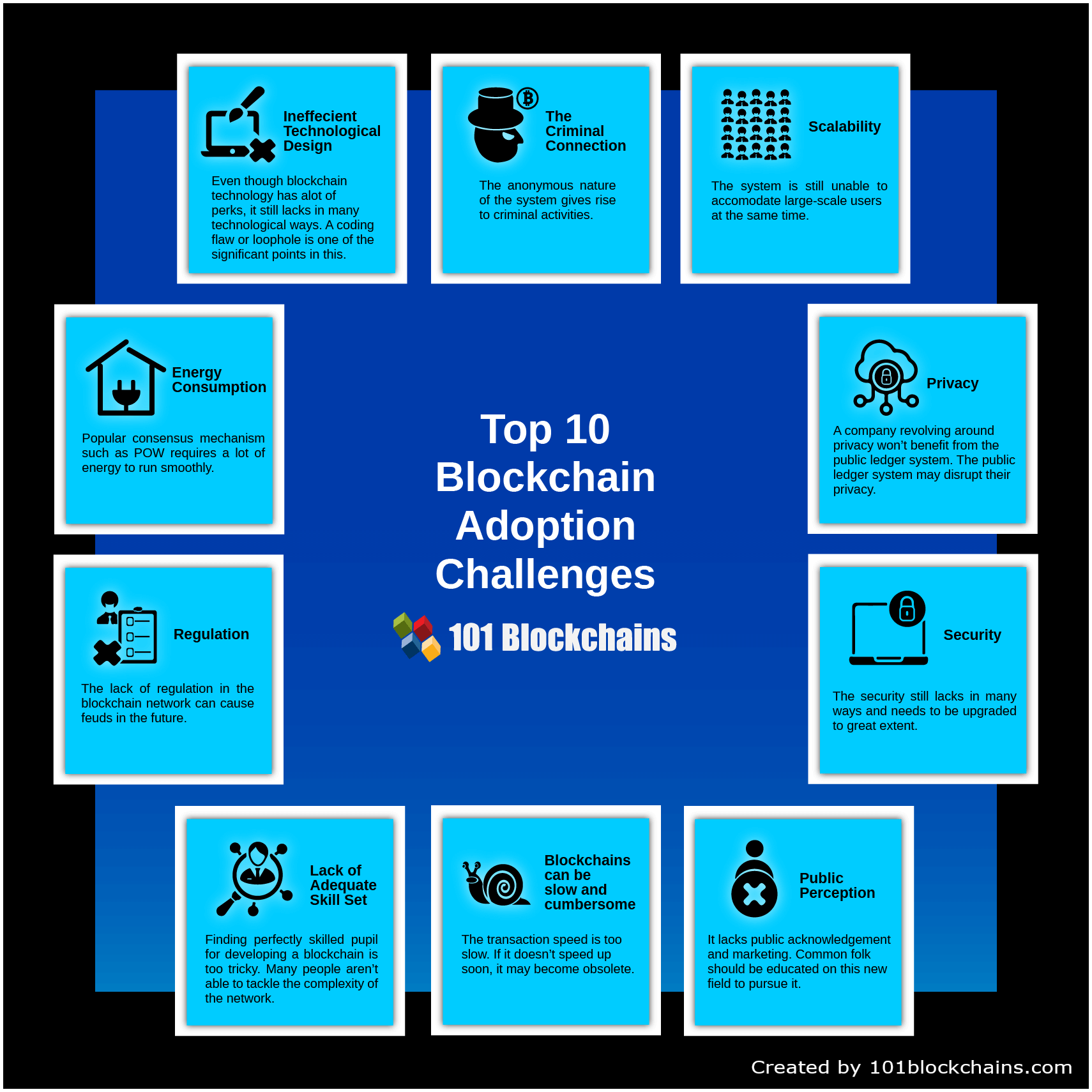
Please include attribution to 101blockchains.com with this graphic. <a href='https://101blockchains.com/blockchain-infographics/'> <img src='https://101blockchains.com/wp-content/uploads/2018/09/Blockchain_Adoption_Challenges.png' alt='Top 10 Blockchain Adoption Challenges='0' /> </a>
We will be skipping the ones we discussed previously in this guide. So, let’s see what the new adoption challenges are –
Human Factors –
-
Regulations
Blockchain technology doesn’t really come with any specific regulations. But it has its faults. Even though it offers benefits, but there isn’t any official security about it. So, it’s one of the prominent enterprise blockchain adoption challenges.
-
Criminal Connection
From the start due to the anonymous nature of bitcoin, it was used in the dark web to pay for black market products. And so, this criminal connection left a bad impression on many organizations. Moreover, to deal with this, you need to overcome your fears of criminal connection.
-
Public Perception
Many are still not sure about blockchain for enterprise projects as they know very little about the technology. Moreover, the technology needs to reach more audiences in order to get worldwide recognition.
Technological Factors –
-
Scalability
Blockchain for enterprise still suffers from scalability issues. So, when a great number of people starts to use the network, the system slows down drastically. But with a closed environment like enterprises, we don’t think you’ll be facing this issue.
-
Energy Consumption
Many blockchains for enterprise networks use energy hungry consensus algorithm on the network. So, mass adoption using these systems would mean a greater loss of energy. However, there are many cases, where good enterprise blockchains are using energy efficient platforms.
-
Privacy
Privacy is a great enterprise blockchain adoption challenge because many organizations want privacy and public blockchains fail to do so. But to overcome this, they need to limit the access of certain users in order to safeguard precious information.
-
Security
Security is a crucial enterprise blockchain adoption challenge. Even though there is quite a lot of security, but there are some loops that can make it prone to attacks. However, 51% attack is highly unlikely.
-
Slow Performance
Yes, we know enterprise blockchain boasts about being fast. But sometimes they can be quite slow. It’s mostly connected to scalability enterprise adoption challenge. Furthermore, more participants can slow down the performance drastically.
Know more details about adoption challenges from our blockchain for enterprise pdf and enterprise blockchains ppt.
Chapter-9: The Transformation Playbook
Transforming a company comes with its own set of hurdles. But we figured out these five basic steps that are necessary for any company to implement blockchain for enterprise. Check out the step from our transformation playbook below:
- Start Small
- Build a Task Force
- Train & Educate
- Develop Strategy
- Communications
Let’s go into more details so that you know just what to do.
Blockchain Transformation Playbook Infographic

Please include attribution to 101blockchains.com with this graphic. <a href='https://101blockchains.com/blockchain-infographics/'> <img src='https://101blockchains.com/wp-content/uploads/2019/01/blockchain_transformation_playbook.png' alt='blockchain transformation playbook='0' /> </a>
-
Start with Smaller Projects
You are going to start a new venture so starting with small projects would be the wisest choice in the start. Why? Because focusing on small-time projects have fewer risks than going for a full transformation. Moreover, if you can perfect your small projects, then you can get a set an achievable roadmap for your company easily.
Also, this will attract stakeholders, and they will show more involvement and take good initiatives.
But you need to make sure that the small project you are doing can have a great impact. Go with your entrepreneur spirit and use technology in a creative way that can benefit the customers and your company.
Try to follow these basic guidelines for that –
- Clear up the objective
- Study the feasibility of the project to ensure the success
- Collaborate between the existing development team and external team to have a full focus on the project
- Get some progress within the first six months
But before you jump in take a look at some of the preferred niches for starting your project –
- Financial industry
- Government
- Supply chain
- Manufacturing
- Real estate
- Education
- Healthcare
- Legal industry
- IoT
- Transportation
These are some few ideas to get you started. You can always go to other sectors; it will all depend on your company and your requirements. But choose the project wisely at it will be your first selling point.
-
Build a Blockchain for Enterprise Task Force
Obviously, if you are going to invest in blockchain for enterprise, then you would need the right people to back you up. Moreover, they need to have faster output too. That’s why you always need to work with experts in this niche.
But hiring or seeking out experts in this field might be a little tricky. So, hiring from outside might not be the usual case here.
Developing the Team
Try to see what other companies are doing in this regard or from where they are hiring their human resources. These are some of the most crucial factors in case of blockchain for enterprise. Moreover, for your business, you’d need a team of people who have the expertise, leadership along with inactiveness. But your task force also needs to be centralized, focusing only on the company’s project.
The goal of your team needs to be –
- Create useful enterprise blockchain use cases
- Develop the blockchain for enterprise capabilities from scratch
- Create processes for different phases of the small project
- Test out the processes to ensure perfection
- Seek out more experts whenever needed
- Follow a special standard for the blockchain for enterprise project
Checklist for the Skills Your Task Force Needs –
- Deep understanding of the whole concept of blockchain technology and the model.
- Being able to develop smart contract out of scratch.
- Deep understanding of typical data structure and how they can link it to applications.
- Expert in cryptography.
- Up-to-date coding skills.
- Ability to implement blockchain as a service.
-
Train Your Teams
Now it’s time for you to train your task force team. Training is always compulsory even though they are experts still coping with your companies need might be a little bit new to anyone. So, make sure you train the existing developers along with the newest addition ones.
Try out online resources there are many portals for training such as YouTube videos or podcasts to dive more into the core of the technology. It will be cost-effective because most of these contents are actually free.
Also, training them to be cooperative and work in a friendly environment is also important. Therefore, you could try team making courses to establish a great bond between your task force members and you. This way you will be able to make them more enthusiasts about the project.
Take a look at what the training material should include –
- What blockchain is and the application along with benefits.
- Impact of blockchain on economic and financial institutions.
- Case studies of popular blockchain for enterprise implementations.
- Technical briefing of how the model works and what can be the challenges.
- What tools are available on the market.
-
Develop the Strategy
Now it’s time to develop the strategy with your team. Without a solid strategy, it could be hard to implement the project and market it wisely. Since you find so many blockchains for enterprise implementation on the market, you would have to create your own set of goals. But the process could be hard and overcoming the challenges can be quite overwhelming.
But don’t worry, many are slowly working on it and so can you too. You must be thinking why the strategy is the first step in the transformation? But the fact is without a task force or a proper training there won’t be a good strategy outcome, to begin with.
So, it’s best to go with the training fist so that they can come up with good strategies.
Find more opportunities for your company to use. You can use customer demands to find out possible new features. Therefore, check out what the consumer wants and how they want it. Try to build your strategy of execution around that.
Also, quote out the challenges of the traditional issue your project will solve in case of marketing the project. If you can market your blockchain for enterprise project efficiently, then it would get more impact in the marketplace.
-
Develop Internal and External Communications
This is the last but one of the most important steps of all. You would have to maintain your internal and external communications accordingly as it would define the probable outcome of your project. Try to keep a good relationship with the stakeholders.
Re-evaluate the impact of your project in front of all your investors. If you can relay the message successfully, then you would be able to impress them and hopefully keep working on the project.
Moreover, make sure your project is within the law. Anything outside the law can induce a bad reaction for the consumers. So, try to cover all the regulations. Moreover, communicating with the customers too. Maybe you announced the launch of your products and your customer should have certain questions about it.
Try to give them proper feed about your blockchain for enterprise project. This way you’ll create a positive reaction from them.
Chapter-10: Final Words
Blockchain technology is evolving as time goes by. According to Gartner Trend Insights, a single enterprise build around blockchain will be valued more than $10 million by 2022. But this is not what shocks us. According to them, they expect all the businesses in this industry to be $176 billion by 2025 and $3.1 trillion by the year 2030.
So, it’s going to be a massive industry. If you don’t fix your spot form now, you might get left behind. We have already told you few tricks to secure your spot in this $3 trillion of value. So, what are waiting for? Start exploring blockchain now!
Are you a DOER? Join our community now!
Want to know everything about blockchain? Enroll now for blockchain certification and courses.


